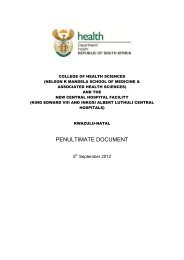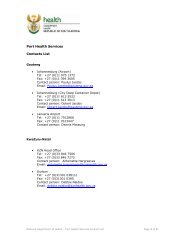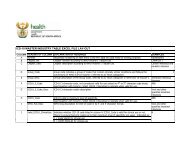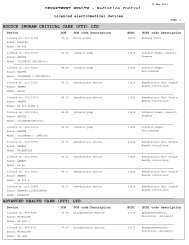eHealth Strategy South Africa 2012 - Department of Health
eHealth Strategy South Africa 2012 - Department of Health
eHealth Strategy South Africa 2012 - Department of Health
Create successful ePaper yourself
Turn your PDF publications into a flip-book with our unique Google optimized e-Paper software.
National <strong>e<strong>Health</strong></strong> <strong>Strategy</strong>, <strong>South</strong> <strong>Africa</strong> <strong>2012</strong>/13-2016/17<br />
A Long and <strong>Health</strong>y Life for All <strong>South</strong> <strong>Africa</strong>ns<br />
Page 1
National <strong>e<strong>Health</strong></strong> <strong>Strategy</strong>, <strong>South</strong> <strong>Africa</strong> <strong>2012</strong>/13-2016/17<br />
Page 2
Table <strong>of</strong> Contents<br />
National <strong>e<strong>Health</strong></strong> <strong>Strategy</strong>, <strong>South</strong> <strong>Africa</strong> <strong>2012</strong>/13-2016/17<br />
Foreword ............................................................................................................................................... 5<br />
Acknowledgement ................................................................................................................................ 6<br />
1. Introduction ..................................................................................................................................... 7<br />
2. Vision, Mission, Aim and Key Principles <strong>of</strong> this strategy .................................................................. 8<br />
3. Problem statement and challenges .................................................................................................. 9<br />
4. Situational Analysis ........................................................................................................................ 10<br />
5. <strong>e<strong>Health</strong></strong>’s contribution to NDoH’s strategic aims ............................................................................ 20<br />
6. Objectives: <strong>e<strong>Health</strong></strong> interventions required ................................................................................... 26<br />
7. <strong>e<strong>Health</strong></strong> Roadmap and delivery on the <strong>e<strong>Health</strong></strong> <strong>Strategy</strong> ............................................................... 27<br />
8. Acronyms used in this document ................................................................................................... 32<br />
Page 3
National <strong>e<strong>Health</strong></strong> <strong>Strategy</strong>, <strong>South</strong> <strong>Africa</strong> <strong>2012</strong>/13-2016/17<br />
Page 4
Foreword by the Minister<br />
Effective monitoring <strong>of</strong> healthcare service delivery and overall<br />
performance <strong>of</strong> the health systems requires functional health<br />
information systems capable <strong>of</strong> producing real time information<br />
for decision making. Globally, Information and Communication<br />
Technology (ICT) has emerged as a critical enabling mechanism to<br />
achieve this. This <strong>e<strong>Health</strong></strong> <strong>Strategy</strong> for the public health sector in<br />
<strong>South</strong> <strong>Africa</strong> ushers in a new era <strong>of</strong> optimism about the capabilities<br />
<strong>of</strong> our health information systems.<br />
Historically, health information systems in <strong>South</strong> <strong>Africa</strong> have been<br />
characterised by fragmentation and lack <strong>of</strong> coordination, prevalence<br />
<strong>of</strong> manual systems and lack <strong>of</strong> automation, and where automation<br />
existed, there was a lack <strong>of</strong> interoperability between different<br />
systems. Considerable resources were also invested in these<br />
systems that, in the final analysis, did not generate the expected<br />
returns on investment.<br />
In August 2009, the National <strong>Health</strong> Council (NHC), chaired<br />
by myself and comprising <strong>of</strong> the 9 Provincial MECs for <strong>Health</strong>,<br />
resolved that the acquisition <strong>of</strong> s<strong>of</strong>tware solutions which were<br />
not interoperable should be halted until the <strong>e<strong>Health</strong></strong> <strong>Strategy</strong> for<br />
<strong>South</strong> <strong>Africa</strong> is finalised. The strategy should provide us with a clear<br />
roadmap that guides us from the current status to an integrated<br />
and well functioning national patient-based information system,<br />
based on agreed upon scientific standards for interoperability, which<br />
improves the efficiency <strong>of</strong> clinical care, produces the indicators<br />
required by management, and facilitates patient mobility. The<br />
architecture <strong>of</strong> this system should also enable an interface with<br />
other transversal systems used in health sector. Such a system is<br />
also a critical enabling factor for the implementation <strong>of</strong> National<br />
<strong>Health</strong> Insurance (NHI).<br />
The <strong>e<strong>Health</strong></strong> <strong>Strategy</strong> for the public health sector provides<br />
the roadmap for achieving a well functioning national health<br />
information system with the patient located at the centre.<br />
The Ministry <strong>of</strong> <strong>Health</strong> and the NHC will closely monitor the<br />
implementation <strong>of</strong> this strategy, to ensure that previous errors do<br />
not revisit us and that the strategy indeed supports patient care and<br />
healthcare management.<br />
________________________________<br />
DR. A. MOTSOALEDI, MP<br />
MINISTER OF HEALTH<br />
DATE: 9 July <strong>2012</strong><br />
National <strong>e<strong>Health</strong></strong> <strong>Strategy</strong>, <strong>South</strong> <strong>Africa</strong> <strong>2012</strong>/13-2016/17<br />
Minister <strong>of</strong> <strong>Health</strong><br />
Dr Aaron Motsoaledi<br />
Deputy Minister <strong>of</strong> <strong>Health</strong><br />
Dr Gwen Ramokgopa<br />
Page 5
National <strong>e<strong>Health</strong></strong> <strong>Strategy</strong>, <strong>South</strong> <strong>Africa</strong> <strong>2012</strong>/13-2016/17<br />
Acknowledgement<br />
Page 6<br />
Director-General for <strong>Health</strong><br />
Ms MP Matsoso<br />
This strategy aims to support the strategic objectives <strong>of</strong> the <strong>Department</strong> <strong>of</strong> <strong>Health</strong> in a way that is<br />
comprehensive, pragmatic and innovative. It defines <strong>e<strong>Health</strong></strong> as a broad domain which includes m<strong>Health</strong>,<br />
telemedicine and all information communication technologies (ICTs) used to promote, support and<br />
strengthen healthcare.<br />
Linking its vision and mission to the health sector’s Negotiated Service Delivery Agreement 2010-2014, it<br />
aims to supports the medium-term priorities <strong>of</strong> the public health sector, pave the way for future public<br />
sector <strong>e<strong>Health</strong></strong> requirements, and lay the requisite foundations for the future integration and coordination<br />
all <strong>e<strong>Health</strong></strong> initiatives in the country (both public sector and private sector).<br />
The strategy adopts a set <strong>of</strong> principles which include getting the basics right, taking an incremental<br />
approach, building on what already exists and looking for early wins.<br />
The document includes a thorough situational analysis and takes a clear look at the challenges facing the<br />
country as it moves forward to fulfil the aims <strong>of</strong> the strategy.<br />
Finally, ten strategic priorities for <strong>e<strong>Health</strong></strong> are identified and the key activities required for each <strong>of</strong> these<br />
priorities are outlined, with accompanying commencement and completion dates within the period <strong>2012</strong>-<br />
2016. These ten priorities that must be acted on are:<br />
1. <strong>Strategy</strong> and Leadership<br />
2. Stakeholder Engagement<br />
3. Standards and interoperability<br />
4. Governance and Regulation<br />
5. Investment, Affordability and Sustainability<br />
6. Benefits realisation<br />
7. Capacity and workforce<br />
8. <strong>e<strong>Health</strong></strong> foundations<br />
9. Applications and Tools to support healthcare delivery<br />
10. Monitoring and Evaluation <strong>of</strong> the <strong>e<strong>Health</strong></strong> <strong>Strategy</strong><br />
This strategy is a product <strong>of</strong> a concerted effort by a team <strong>of</strong> <strong>of</strong>ficials from the National DoH and the Medical<br />
Research Council (MRC) who worked tirelessly to develop it, in constant consultation with the National<br />
<strong>Health</strong> Information Systems Committee <strong>of</strong> <strong>South</strong> <strong>Africa</strong> (NHIS/SA).<br />
The Technical Advisory Committee (TAC) <strong>of</strong> the National <strong>Health</strong> Council (NHC) will provide the technical<br />
oversight required to ensure successful implementation <strong>of</strong> this strategy.<br />
______________________________<br />
MS MP MATSOSO<br />
DIRECTOR-GENERAL: DEPARTMENT OF HEALTH<br />
DATE: 01 June <strong>2012</strong>
1. Introduction<br />
1.1 What is <strong>e<strong>Health</strong></strong>?<br />
National <strong>e<strong>Health</strong></strong> <strong>Strategy</strong>, <strong>South</strong> <strong>Africa</strong> <strong>2012</strong>/13-2016/17<br />
The World <strong>Health</strong> Organisation defines <strong>e<strong>Health</strong></strong> as “the use <strong>of</strong> information and communication technologies<br />
(ICTs) for health to, for example, treat patients, pursue research, educate students, track diseases and<br />
monitor public health.” 1<br />
This short definition covers a vast domain, including:<br />
• Electronic <strong>Health</strong> Records (enabling sharing <strong>of</strong> patient data between points <strong>of</strong> care),<br />
• Routine health management information (e.g. web-based surveillance systems, electronic disease<br />
registers, electronic district health information systems),<br />
• Vital Registration (the use <strong>of</strong> computerised systems for registration <strong>of</strong> death or births),<br />
• Consumer <strong>Health</strong> Informatics (access to information on health by healthy individuals or patients),<br />
• <strong>Health</strong> Knowledge Management (e.g. best practice guidelines managed and accessed electronically),<br />
• m<strong>Health</strong> (e.g. use <strong>of</strong> mobile devices such as cell-phones to share information or to collect aggregate<br />
or patient data),<br />
• Telemedicine (e.g. use <strong>of</strong> ICTs to provide care at a distance),<br />
• Virtual <strong>Health</strong>care (e.g. teams <strong>of</strong> pr<strong>of</strong>essionals working together via ICTs), and<br />
• <strong>Health</strong> Research (e.g. use <strong>of</strong> high performance computing to handle large volumes <strong>of</strong> data).<br />
This strategy adopts the above definition <strong>of</strong> <strong>e<strong>Health</strong></strong> and aims to comply with the resolution WHA58.28 on<br />
<strong>e<strong>Health</strong></strong>, adopted by the 58th World <strong>Health</strong> Assembly in 2005. 2<br />
1.2 The 10 Strategic Priorities<br />
Ten strategic priorities that must be addressed in order to leverage <strong>e<strong>Health</strong></strong> to strengthen healthcare<br />
transformation in <strong>South</strong> <strong>Africa</strong> are:<br />
1. <strong>Strategy</strong> and Leadership<br />
2. Stakeholder Engagement<br />
3. Standards and Interoperability<br />
4. Governance and Regulation<br />
5. Investment, Affordability and Sustainability<br />
6. Benefits Realisation<br />
7. Capacity and Workforce<br />
8. <strong>e<strong>Health</strong></strong> Foundations<br />
9. Applications and Tools to support <strong>Health</strong>care Delivery<br />
10. Monitoring and Evaluation <strong>of</strong> the <strong>e<strong>Health</strong></strong> <strong>Strategy</strong><br />
1 http://www.who.int/topics/ehealth/en/<br />
2 http://www.who.int/healthacademy/media/en/<strong>e<strong>Health</strong></strong>_EB_Res-en.pdf<br />
Page 7
National <strong>e<strong>Health</strong></strong> <strong>Strategy</strong>, <strong>South</strong> <strong>Africa</strong> <strong>2012</strong>/13-2016/17<br />
2. Vision, Mission, Aim and Key Principles <strong>of</strong> this strategy<br />
2.1 Vision<br />
<strong>e<strong>Health</strong></strong>: enabling a long and healthy life for all <strong>South</strong> <strong>Africa</strong>ns.<br />
2.2 Mission<br />
To establish <strong>e<strong>Health</strong></strong> as an integral part <strong>of</strong> the transformation and improvement <strong>of</strong> healthcare services in<br />
<strong>South</strong> <strong>Africa</strong>, especially enabling delivery on the health sector’s Negotiated Service Delivery Agreement<br />
2010-2014.<br />
2.3 Aim<br />
The overall aim <strong>of</strong> this strategy is to provide a single, harmonised and comprehensive <strong>e<strong>Health</strong></strong> strategy that:<br />
a) Supports the medium-term priorities <strong>of</strong> the public health sector.<br />
b) Paves the way for future public sector <strong>e<strong>Health</strong></strong> requirements.<br />
c) Lays the requisite foundations for the future integration and coordination <strong>of</strong> all <strong>e<strong>Health</strong></strong> initiatives in the<br />
country (both public sector and private sector) 3 .<br />
2.4 Key principles<br />
In order to best overcome the challenges listed above, the programme <strong>of</strong> work that will lead from this<br />
strategy will have to be underpinned by certain key principles, i.e. fundamental assumptions that will guide<br />
decision-making by the National and Provincial <strong>Department</strong>s <strong>of</strong> <strong>Health</strong>.<br />
These principles are:<br />
• Get the basics right – infrastructure, connectivity, basic ICT literacy, human resources and<br />
affordability planning.<br />
• Take an incremental approach – build on what exists already in both the public and private sectors<br />
and fill the gaps where necessary.<br />
• Look for early wins in implementations and benefits to build the confidence <strong>of</strong> health pr<strong>of</strong>essionals,<br />
patients and the public in <strong>e<strong>Health</strong></strong>.<br />
• Advocate the benefits <strong>of</strong> care enabled by <strong>e<strong>Health</strong></strong> and ensure that these benefits are realised.<br />
• Constantly evaluate <strong>e<strong>Health</strong></strong> initiatives and measure improvements in health outcomes in order to<br />
build an evidence base that demonstrates the net benefits over time <strong>of</strong> <strong>e<strong>Health</strong></strong> and guides planning<br />
and decision-making.<br />
• Establish national co-ordination on all initiatives in order to improve the effectiveness <strong>of</strong> <strong>e<strong>Health</strong></strong> at<br />
all levels.<br />
o Enable integration between systems wherever appropriate.<br />
o Enforce common standards, norms and systems across the country. 4<br />
o Establish common data standards and terminology across information systems.<br />
• Encourage a collaborative approach by leveraging partnerships, e.g. private sector, NGOs, other<br />
government departments, other country governments, research organisations.<br />
3 The National <strong>Health</strong> Act <strong>of</strong> 2003 empowers the Minister <strong>of</strong> <strong>Health</strong> to regulate both the public and private health care sectors.<br />
4 NSDA on <strong>Health</strong> for period 2010-2014 Sub-output 4.4.8 Strengthening <strong>Health</strong> Information Systems<br />
Page 8
National <strong>e<strong>Health</strong></strong> <strong>Strategy</strong>, <strong>South</strong> <strong>Africa</strong> <strong>2012</strong>/13-2016/17<br />
• Protect information security, confidentiality and patient privacy at all times.<br />
• Promote information governance consensus among all stakeholders in order to use information<br />
better.<br />
• When required, procure cost-effective and re-usable information systems in order to get value for<br />
money.<br />
• Consider available open source solutions for cost effectiveness.<br />
• Build the capacity and the systems to obtain <strong>of</strong>ficial health statistics from a single <strong>of</strong>ficial source 5 .<br />
• Adhere to the NHIS/SA principles for information management. 6<br />
• Ensure that intellectual property ownership <strong>of</strong> public sector <strong>e<strong>Health</strong></strong> initiatives are vested in<br />
government.<br />
In addition to the above principles, the strategy seeks to provide benefits within the six domains <strong>of</strong><br />
healthcare quality put forward by the Institute <strong>of</strong> Medicine (IOM) and the additional imperative <strong>of</strong><br />
improving access. These six domains are:<br />
• Safety: Avoiding harm to patients from the care that is intended to help them.<br />
• Effectiveness: Providing services based on scientific knowledge to all who could benefit and refraining<br />
from providing services to those not likely to benefit (avoiding underuse and misuse, respectively).<br />
• Patient-centeredness: Providing care that is respectful <strong>of</strong> and responsive to individual patient<br />
preferences, needs, and values and ensuring that patient values guide all clinical decisions.<br />
• Timeliness: Reducing waiting times and potentially harmful delays for both those who receive and<br />
those who give care.<br />
• Efficiency: Avoiding waste, including waste <strong>of</strong> equipment, supplies, ideas, and energy.<br />
• Equitability: Providing care that does not vary in quality because <strong>of</strong> personal characteristics such as<br />
gender, ethnicity, geographic location, and socioeconomic status.<br />
3. Problem statement and challenges<br />
The following quotation from the NSDA 2010-2014 sums up the problem statement for this <strong>e<strong>Health</strong></strong><br />
strategy: “Although large sums <strong>of</strong> money have been used to procure health ICT and HIS in <strong>South</strong> <strong>Africa</strong> in<br />
the past, the ICT and HIS within the <strong>Health</strong> System is not meeting the requirements to support the business<br />
processes <strong>of</strong> the health system thus rendering the healthcare system incapable <strong>of</strong> adequately producing<br />
data and information for management and for monitoring and evaluating the performance <strong>of</strong> the national<br />
health system. This results from the lack <strong>of</strong> technology regulations and a lack <strong>of</strong> policy frameworks for all<br />
aspects <strong>of</strong> infrastructure delivery.” 8<br />
The quotation highlights key challenges identified in relation to <strong>e<strong>Health</strong></strong>. The following are specific<br />
challenges identified with respect to <strong>e<strong>Health</strong></strong>, particularly in the public sector:<br />
• No national <strong>e<strong>Health</strong></strong> strategy and corresponding Enterprise Architecture supporting the national<br />
health system.<br />
• Limited capacity or capabilities within the public sector to implement a national <strong>e<strong>Health</strong></strong> strategy.<br />
5 NSDA on <strong>Health</strong> for period 2010-2014 Sub-output 4.4.8 Strengthening <strong>Health</strong> Information Systems<br />
6 The strategy also takes into account the key principles adopted by NHIS/SA.<br />
• Data to be collected at the point <strong>of</strong> its generation.<br />
• Data collection is to enable service assessment as well as self-assessment.<br />
• Service delivery personnel would have responsibility for the collection <strong>of</strong> data relevant to their specific duties.<br />
• Where feasible, the basic analysis <strong>of</strong> the data would be carried out at the point <strong>of</strong> collection.<br />
• Collection, aggregation and analysis <strong>of</strong> data would follow the organisational structure <strong>of</strong> health services, that is national data would comprise <strong>of</strong><br />
the sum <strong>of</strong> the provinces, provincial data <strong>of</strong> the sum <strong>of</strong> its districts, district data <strong>of</strong> the sum <strong>of</strong> its sub-districts.<br />
7 Institute <strong>of</strong> Medicine (IOM).Crossing the Quality Chasm: A New <strong>Health</strong> System for the 21st Century. Washington, D.C: National Academy Press;<br />
2001.<br />
8 NSDA on <strong>Health</strong> for period 2010-2014, page 9.<br />
Page 9
National <strong>e<strong>Health</strong></strong> <strong>Strategy</strong>, <strong>South</strong> <strong>Africa</strong> <strong>2012</strong>/13-2016/17<br />
• Widely differing levels <strong>of</strong> <strong>e<strong>Health</strong></strong> maturity across and within provinces.<br />
• A large number <strong>of</strong> disparate systems between which there is little or no interoperability and<br />
communication.<br />
• Silos <strong>of</strong> information within levels <strong>of</strong> government, government departments and programmes within<br />
the national and provincial departments <strong>of</strong> health, resulting in duplication <strong>of</strong> effort and disparities in<br />
reporting.<br />
• Inequity <strong>of</strong> <strong>e<strong>Health</strong></strong> services provided and expenditure 9 on <strong>e<strong>Health</strong></strong> across national and provincial<br />
departments <strong>of</strong> health. (This may be related to differing strategic importance placed on <strong>e<strong>Health</strong></strong>).<br />
• Broadband connectivity is expensive and still out <strong>of</strong> reach <strong>of</strong> many.<br />
• A low degree <strong>of</strong> cooperation, collaboration and sharing across all sectors.<br />
• Several past initiatives have not reached fruition because <strong>of</strong> poor planning or lack <strong>of</strong> consistent<br />
sponsorship, management and/or funding.<br />
• Need for strong information governance to ensure compliance with the necessary standards and<br />
procedures for, and appropriate use <strong>of</strong>, health information (both patient-based and aggregate).<br />
• Different organisational structures for <strong>e<strong>Health</strong></strong> service provision exist in provinces, e.g. health ICT<br />
services may reside within a department <strong>of</strong> health but in an inappropriate section, or within another<br />
department.<br />
• The absence <strong>of</strong> a national master patient index and lack <strong>of</strong> consensus on unique identification <strong>of</strong><br />
patients.<br />
• A lack <strong>of</strong> cooperation between various groups resulting from lack <strong>of</strong> a clear understanding that<br />
<strong>e<strong>Health</strong></strong> includes all ICTs for health such as mobile technologies, telemedicine and electronic patient<br />
records. This lack <strong>of</strong> cooperation prevents urgently needed progress in using <strong>e<strong>Health</strong></strong> as an enabler.<br />
4. Situational Analysis<br />
4.1 Structural, Policy and Legislative Context<br />
As early as 1997, the NDoH published the White Paper for the Transformation <strong>of</strong> the <strong>Health</strong> System in <strong>South</strong><br />
<strong>Africa</strong>. The White Paper advocated the establishment <strong>of</strong> a comprehensive national health information<br />
system with two components:<br />
• Management information and disease surveillance systems.<br />
• Population health and demographic surveillance.<br />
<strong>Health</strong> services in <strong>South</strong> <strong>Africa</strong> are delivered across three levels <strong>of</strong> government: national, provincial<br />
and local. In terms <strong>of</strong> the <strong>South</strong> <strong>Africa</strong>n Constitution 10 , both national and provincial governments have<br />
concurrent jurisdiction over health as a service delivery area, i.e. both make decisions and have a duty<br />
to deliver services. In practice, the role <strong>of</strong> the NDoH focuses on legislation, policy, norms and standards,<br />
and ensuring equity, while the role <strong>of</strong> the provincial departments <strong>of</strong> health is focused on the planning,<br />
budgeting and delivery <strong>of</strong> health services at the coal face. Local government is responsible for the delivery<br />
<strong>of</strong> municipal health services as stipulated in the National <strong>Health</strong> Act No. 61 <strong>of</strong> 2003.<br />
The delivery <strong>of</strong> <strong>e<strong>Health</strong></strong> services (as defined above) in public sector facilities is the responsibility <strong>of</strong> the<br />
provincial departments <strong>of</strong> health. The responsibility for <strong>e<strong>Health</strong></strong> policy and strategy development resides<br />
with the NDoH. In terms <strong>of</strong> Section 74 <strong>of</strong> the National <strong>Health</strong> Act, the NDoH is responsible for the facilitation<br />
and coordination <strong>of</strong> health information. The Act stipulates that “the national department must facilitate and<br />
coordinate the establishment, implementation and maintenance by provincial departments, district health<br />
councils, municipalities and the private health sector <strong>of</strong> health information systems at national, provincial<br />
and local levels in order to create a comprehensive national health information system”. 11<br />
9 Survey on ICTs in <strong>Health</strong> conducted by the National <strong>e<strong>Health</strong></strong> Steering Committee, September 2009.<br />
10 Constitution <strong>of</strong> Republic <strong>of</strong> <strong>South</strong> <strong>Africa</strong>, No. 108 <strong>of</strong> 1996. Schedule 4, Part A.<br />
11 National <strong>Health</strong> Act No. 61 <strong>of</strong> 2003, Section 74[1].<br />
Page 10
National <strong>e<strong>Health</strong></strong> <strong>Strategy</strong>, <strong>South</strong> <strong>Africa</strong> <strong>2012</strong>/13-2016/17<br />
The Act empowers the National Minister <strong>of</strong> <strong>Health</strong> to “prescribe categories or kinds <strong>of</strong> data for submission<br />
and collection and the manner and format in which and by whom the data must be compiled or collated and<br />
must be submitted to the national department”. 12<br />
The NDoH exercises its coordination and facilitation role through the National <strong>Health</strong> Information System <strong>of</strong><br />
<strong>South</strong> <strong>Africa</strong> (NHIS/SA) committee.<br />
The NHIS/SA committee was established in 1994 with the broad objectives <strong>of</strong>:<br />
• Ensuring the availability <strong>of</strong> information for the management <strong>of</strong> health services.<br />
• Measuring the health status <strong>of</strong> the <strong>South</strong> <strong>Africa</strong>n population.<br />
• Coordinating country-wide health information systems.<br />
The membership <strong>of</strong> the NHIS/SA committee consists <strong>of</strong> senior managers in the NDoH responsible for health<br />
information, monitoring and evaluation, epidemiology, and research; senior managers responsible for<br />
similar functions in the provinces, and invited representatives from partners and other organisations. The<br />
NHIS/SA committee meets quarterly and reports to the Director-General <strong>of</strong> the NDoH.<br />
4.2 The Requirement for a National <strong>e<strong>Health</strong></strong> <strong>Strategy</strong><br />
There are various international and national mandates for a national <strong>e<strong>Health</strong></strong> strategy.<br />
At the fifty-eighth session <strong>of</strong> the World <strong>Health</strong> Assembly (WHA) in May 2005, Resolution WHA 58.28 on<br />
<strong>e<strong>Health</strong></strong> was adopted. 13 The resolution urges member states:<br />
• To draw up long-term strategic plans for developing and implementing <strong>e<strong>Health</strong></strong> services that includes<br />
an appropriate legal framework and infrastructure and encourages public and private partnerships.<br />
• To develop the infrastructure for ICTs for health as deemed appropriate to promote equitable,<br />
affordable, and universal access to their benefits, and to continue to work with information<br />
telecommunication agencies and other partners to strive to reduce costs to make <strong>e<strong>Health</strong></strong> successful.<br />
• To strive for closer collaboration with the private and non-pr<strong>of</strong>it sectors in information and<br />
communication technologies, in order to further public services for health.<br />
• To endeavour to reach communities, including vulnerable groups, with <strong>e<strong>Health</strong></strong> services appropriate<br />
to their needs.<br />
• To mobilise multi-sector collaboration for determining evidence-based <strong>e<strong>Health</strong></strong> standards and norms.<br />
• To evaluate <strong>e<strong>Health</strong></strong> activities, and to share the knowledge <strong>of</strong> cost effective models, thus ensuring<br />
quality, safety and ethical standards.<br />
• To establish national centres and networks <strong>of</strong> excellence for <strong>e<strong>Health</strong></strong> best practice, policy<br />
coordination, and technical support for healthcare delivery, service improvement, information to<br />
citizens, capacity building, and surveillance.<br />
• To consider establishing and implementing national public health information systems.<br />
• To improve, by means <strong>of</strong> information, the capacity for the surveillance <strong>of</strong>, and rapid response to,<br />
disease and public health emergencies.<br />
12 National <strong>Health</strong> Act No. 61 <strong>of</strong> 2003, Section 74[2].<br />
13 WHO World <strong>Health</strong> Assembly 2005 resolution on <strong>e<strong>Health</strong></strong> WHA 58.28. http://www.who.int/healthacademy/media/en/<strong>e<strong>Health</strong></strong>_EB_Res-en.pdf<br />
Page 11
National <strong>e<strong>Health</strong></strong> <strong>Strategy</strong>, <strong>South</strong> <strong>Africa</strong> <strong>2012</strong>/13-2016/17<br />
As early as 2001, the Government <strong>of</strong> <strong>South</strong> <strong>Africa</strong> accentuated the need to develop functional information<br />
systems in all government departments. The <strong>South</strong> <strong>Africa</strong>n Public Service Regulations 2001 14 stipulated<br />
the requirement for <strong>Department</strong>s to have in place mechanisms to appropriately manage and develop<br />
information management.<br />
According to E.1, a head <strong>of</strong> a government department shall establish:<br />
• An information plan for the department that supports:<br />
o The planning process and objectives contemplated in regulation III B.<br />
o Compliance with Part I <strong>of</strong> Chapter 5.<br />
• An information infrastructure plan that supports the information plan:<br />
o An operational plan that enables the implementation <strong>of</strong> the information infrastructure plan and<br />
information management.<br />
According to Chapter 5, Part 1 (A): Underlying Electronic Government Value (Principles):<br />
• <strong>Department</strong>s shall manage information technology effectively and efficiently. The Batho Pele 15<br />
principles <strong>of</strong> <strong>of</strong>fering equal access to services, increasing productivity and lowering cost, shall inform<br />
the acquisition, management and use <strong>of</strong> information technology. Information technology shall be<br />
used as a tool to leverage service delivery by the public service and shall therefore not be acquired<br />
for its own sake.<br />
While all government departments are therefore required to have a strategy to support information<br />
management and the use <strong>of</strong> information technology, a strong national <strong>e<strong>Health</strong></strong> strategy that coordinates<br />
the implementation <strong>of</strong> <strong>e<strong>Health</strong></strong> projects and programmes, and guides efforts to strengthen information<br />
management, is essential. It is also essential that the strategies for information management and ICTs in<br />
the provincial departments <strong>of</strong> health are aligned with this national <strong>e<strong>Health</strong></strong> strategy. 16<br />
In addition, the Electronic Communications and Transactions Act (2002) 17 leads all ICT initiatives in the<br />
country by making provisions for the development <strong>of</strong> a five year national e-strategy that aims to enable and<br />
facilitate electronic transactions in the public interest.<br />
Over the last few years there have been several efforts towards drawing up a comprehensive national<br />
<strong>e<strong>Health</strong></strong> strategy for the country. 18, 19, 20 These efforts have contributed to this strategy.<br />
14 Public Service Regulation 2001 : Regulation E <strong>of</strong> Part III <strong>of</strong> Chapter 1<br />
15 Batho Pele – Putting People First. http://www.info.gov.za/aboutgovt/publicadmin/bathopele.htm<br />
16 The World <strong>Health</strong> Organisation distinguishes between three key information related concepts namely: (i) an Information System, which is defined<br />
as “a system that provides information support to the decision-making process at each level <strong>of</strong> an organization” ; (ii) a <strong>Health</strong> Information System,<br />
which is a system that integrates data collection, processing, reporting, and use <strong>of</strong> the information necessary for improving health service effectiveness<br />
and efficiency through better management at all levels <strong>of</strong> health services” ; and (iii) a <strong>Health</strong> Management Information System, which is “an<br />
information system especially designed to assist in the management and planning <strong>of</strong> health programmes, as opposed to delivery <strong>of</strong> care” . It is widely<br />
accepted that health management information systems can build on existing data and health information system standards and infrastructure.<br />
Reference: “Developing <strong>Health</strong> Management Information Systems: A Practical Guide for developing Countries, World <strong>Health</strong> Organization, Regional<br />
Office for the Western Pacific” (2004).<br />
17 Electronic Communications and Transactions Act [No. 25 <strong>of</strong> 2002]. http://www.info.gov.za/view/DownloadFileAction?id=68060<br />
18 PNC on ISAD: White Paper on e-<strong>Health</strong>, November 2007.<br />
19 Draft <strong>e<strong>Health</strong></strong> <strong>Strategy</strong> developed by National <strong>e<strong>Health</strong></strong> Steering Committee, 2009.<br />
20 National Strategic Framework for eHR.ZA Implementation in <strong>South</strong> <strong>Africa</strong>, 2007.<br />
Page 12
4.3 <strong>e<strong>Health</strong></strong> funding and expenditure<br />
National <strong>e<strong>Health</strong></strong> <strong>Strategy</strong>, <strong>South</strong> <strong>Africa</strong> <strong>2012</strong>/13-2016/17<br />
Funding for <strong>e<strong>Health</strong></strong> implementation is located within the provincial and municipal budgets, although there<br />
is no specific allocation from NDoH for <strong>e<strong>Health</strong></strong>. Financial investment in <strong>e<strong>Health</strong></strong> has varied from province to<br />
province and the result has been a marked inequity <strong>of</strong> <strong>e<strong>Health</strong></strong> expenditure across provinces.<br />
An audit <strong>of</strong> deployment <strong>of</strong> ICTs revealed disparities in the treatment <strong>of</strong> ICT as a strategic enabler for<br />
healthcare service delivery in the provinces. 21 Gauteng, Limpopo and KwaZulu-Natal had the largest annual<br />
budgets for 2009: R188.3m, R178.6m and R105m respectively, in nominal terms. On the other end <strong>of</strong> the<br />
spectrum were North West, Northern Cape and Free State with R15m, R20.4m and R32m respectively.<br />
These disparities were also demonstrated in the spending on human resources (HR) for ICT. The percentage<br />
<strong>of</strong> budget committed to personnel ranged from 10% to 25%.<br />
It should also be noted that the total expenditure reported in this audit did not include expenditure by local<br />
authorities, especially the larger metros, which may be substantial. Overall it may be observed that, since<br />
1994, there has been considerable but uncoordinated investment in <strong>e<strong>Health</strong></strong>, with limited tangible benefits<br />
and return on investment.<br />
4.4 <strong>e<strong>Health</strong></strong> Maturity<br />
The landscape analysis <strong>of</strong> HIS in developing countries funded by the Bill and Melinda Gates Foundation 22<br />
provides a categorisation <strong>of</strong> five stages <strong>of</strong> <strong>e<strong>Health</strong></strong> maturity as countries move toward systems <strong>of</strong> greater<br />
scope, scale, and sophistication in HIS. These stages are based on data flow and collection, data utilisation<br />
and integration, resources and capacity, scope, and scale.<br />
Stage 1 - paper-based systems for collecting district health indicators,<br />
Stage 2 - optimisation <strong>of</strong> paper systems through simplifying indicators and reducing duplication,<br />
Stage 3 - migration <strong>of</strong> traditional district health information systems to electronic storage and reporting,<br />
Stage 4 - introduction <strong>of</strong> operational ICT systems as a source <strong>of</strong> data for HIS,<br />
Stage 5 - a fully comprehensive and integrated national HIS.<br />
This report places <strong>South</strong> <strong>Africa</strong> at Stage 3. However, <strong>e<strong>Health</strong></strong> maturity is linked to resource availability and as<br />
a result some provinces are at Stage 2, others at Stage 4, while some may have various regions or districts at<br />
Stages 1, 2 and 3.<br />
In order for <strong>South</strong> <strong>Africa</strong> to move to Stages 4 and 5 it needs to:<br />
• Implement patient-based information systems at all facilities where healthcare is delivered.<br />
• Link all these systems to a national electronic health record system.<br />
• Derive all indicator data from patient data captured electronically at the point <strong>of</strong> care.<br />
• Establish a unique identifier for each <strong>South</strong> <strong>Africa</strong>n.<br />
• Ensure effective registration <strong>of</strong> births and death.<br />
• Support access from all facilities to all records in other facilities.<br />
21 Survey on ICTs in <strong>Health</strong> conducted by the National <strong>e<strong>Health</strong></strong> Steering Committee, September 2009.<br />
22 Vital Wave Consulting (Funded by Bill and Melinda Gates Foundation): <strong>Health</strong> Information Systems in Developing Countries: A Landscape Analysis.<br />
May 2009.<br />
Page 13
National <strong>e<strong>Health</strong></strong> <strong>Strategy</strong>, <strong>South</strong> <strong>Africa</strong> <strong>2012</strong>/13-2016/17<br />
4.5 National <strong>Health</strong>care Management Information System (NHC/MIS)<br />
The National <strong>Health</strong>care Management Information System (NHC/MIS) was drawn up by NDoH in 1994. It<br />
describes the functionality that addresses the day to day management <strong>of</strong> health services which must be<br />
implemented at all levels <strong>of</strong> healthcare. The core modules <strong>of</strong> the NHC/MIS are:<br />
• Patient registration.<br />
• A basic summary care record.<br />
• Patient billing.<br />
• Appointment scheduling.<br />
• Clinical pharmacy.<br />
• A Patient Master Index (PMI).<br />
In 1996 the implementation <strong>of</strong> the NHC/MIS was decentralised and the procurement and implementation<br />
<strong>of</strong> the NHC/MIS modules became the responsibility <strong>of</strong> the provincial departments <strong>of</strong> health and<br />
their accounting <strong>of</strong>ficers, the Heads <strong>of</strong> <strong>Department</strong>. As a result, several disparate systems have been<br />
implemented in the provinces with varying degrees <strong>of</strong> success. The current scenario is illustrated in<br />
Table 1. Besides being implemented on different platforms and databases, these systems vary widely<br />
in their architecture, impact on workflows, usability and support structures. The systems are unable to<br />
communicate with each other (there is no interoperability) and they do not communicate with a National<br />
PMI. 23<br />
The HIS landscape analysis referred to in 4.4 notes the following:<br />
“Despite all the support and active implementations <strong>of</strong> various HIS, not all provinces have all components<br />
<strong>of</strong> the NHC/MIS. EMR systems are somewhat functional in just one-third <strong>of</strong> provincial hospitals. There are<br />
five different proprietary systems in use and there is little integration between them. Computer and Internet<br />
access is not commonly found in state hospitals or at the provincial level. Western Cape Province appears to<br />
be progressive, implementing a central hospital information system with a unique patient ID, a pharmacy<br />
system, digital radiology, and community healthcare clinics and local city clinics that access the same<br />
provincial level patient ID. The private sector also faces the same problem <strong>of</strong> fragmented systems.” 24<br />
Province Patient Management/Hospital Information<br />
Systems in use.<br />
Eastern Cape Delta 9<br />
Free State Meditech; PADS<br />
Gauteng Medicom; Soarian MedSuite; PharmAssist; PAAB<br />
KwaZulu-Natal Medicom; Meditech; PALS; Pro-Clin; ReMed<br />
Limpopo Medicom<br />
Mpumalanga PAAB<br />
North West PAAB<br />
Northern Cape Nootroclin<br />
Western Cape Clinicom; Delta 9; PHCIS; JAC Pharmacy<br />
Table 1. Patient Management/Hospital Information Systems currently deployed in public sector facilities<br />
in <strong>South</strong> <strong>Africa</strong><br />
23 http://www.pnc.gov.za/index.php/e-health/articles-a-events/44-health-care-management-information-system-nhcmis<br />
24 Ibid.<br />
Page 14
National <strong>e<strong>Health</strong></strong> <strong>Strategy</strong>, <strong>South</strong> <strong>Africa</strong> <strong>2012</strong>/13-2016/17<br />
In the last few years the NDoH has made a strategic decision to implement a national Electronic <strong>Health</strong><br />
Record system. The goal <strong>of</strong> this is to allow patient tracking wherever patients present themselves and it<br />
aims to address the above issues <strong>of</strong> lack <strong>of</strong> interoperability, fragmentation and the absence <strong>of</strong> a National<br />
PMI.<br />
4.6 Telemedicine<br />
“Although Telemedicine has long been recognized as an effective means to overcome the challenges in<br />
rural health settings in <strong>South</strong> <strong>Africa</strong>, there has also been a lot <strong>of</strong> skepticism about the practicalities <strong>of</strong> the<br />
technology.” 25 This may partly be blamed on the limited success <strong>of</strong> the national Telemedicine Programme<br />
initiated by NDoH and NHIS/SA in 1999 and 2000.<br />
After installation <strong>of</strong> the hardware, the various services were handed over to the provinces to maintain and<br />
expand. “While aspects <strong>of</strong> the programme showed promise there was limited uptake <strong>of</strong> the project and it<br />
was not successful. There is little to suggest that circumstances have changed, as a major problem factor<br />
in the implementation <strong>of</strong> the project was the shortage <strong>of</strong> healthcare workers in the State sector and their<br />
reluctance to take on any additional work. A second factor was the top down approach and the lack <strong>of</strong><br />
capacity and failure to manage change.” 26<br />
Despite the slow start, telemedicine still holds much promise as a tool to support the delivery <strong>of</strong> healthcare,<br />
especially in rural settings in <strong>South</strong> <strong>Africa</strong>. Telemedicine attracts considerable interest and innovation<br />
among academics, researchers, private enterprise and health pr<strong>of</strong>essionals. Since 1999 there have been<br />
some noteworthy achievements within the public health domain. The NDoH recognises the potential<br />
<strong>of</strong> telemedicine as an “enabling tool that could bridge the gap between rural healthcare and specialist<br />
facilities.” 27<br />
4.7 m<strong>Health</strong><br />
Mobile technology has provided an opportunity to revolutionise healthcare, especially in countries like<br />
<strong>South</strong> <strong>Africa</strong> that have the challenges <strong>of</strong> providing care in deep rural settings but also have a thriving<br />
telecommunications market.<br />
“The <strong>South</strong> <strong>Africa</strong>n telecommunications market is the largest in <strong>Africa</strong> totalling US$25 billion in 2006,<br />
but <strong>South</strong> <strong>Africa</strong> continues to descend down the international scales <strong>of</strong> competitiveness and e-readiness.<br />
Broadband penetration is low and bandwidth is expensive. Mobile phones have given access to millions who<br />
were previously marginalised from personal communications and mobile phone penetration is estimated<br />
at 75% with approximately 90% <strong>of</strong> the country covered by mobile telephony. It is likely that m<strong>Health</strong> will<br />
play an ever increasing role in medical informatics, telemedicine, surveillance and healthcare education in<br />
<strong>Africa</strong>.” 28<br />
25 Media statement Issued by the <strong>South</strong> <strong>Africa</strong>n Medical Research Council (MRC) September 2011. http://www.mrc.ac.za/<br />
pressreleases/2011/12press2011.htm 26 Mars, M and Seebregts, C. Country Case Study for <strong>e<strong>Health</strong></strong>: <strong>South</strong> <strong>Africa</strong>. Rockefeller Foundation. 2008.<br />
http://www.ehealth-connection.org/content/country-case-studies<br />
26 Mars, M and Seebregts, C. Country Case Study for <strong>e<strong>Health</strong></strong>: <strong>South</strong> <strong>Africa</strong>. Rockefeller Foundation. 2008. http://www.ehealth-connection.org/<br />
content/country-case-studies<br />
27 Media statement Issued by the <strong>South</strong> <strong>Africa</strong>n Medical Research Council (MRC) September 2011. http://www.mrc.ac.za/<br />
pressreleases/2011/12press2011.htm<br />
28 Mars, M and Seebregts, C. Country Case Study for <strong>e<strong>Health</strong></strong>: <strong>South</strong> <strong>Africa</strong>. Rockefeller Foundation. 2008. http://www.ehealth-connection.org/<br />
content/country-case-studies<br />
Page 15
National <strong>e<strong>Health</strong></strong> <strong>Strategy</strong>, <strong>South</strong> <strong>Africa</strong> <strong>2012</strong>/13-2016/17<br />
There have been several successful m<strong>Health</strong> initiatives in <strong>South</strong> <strong>Africa</strong>, including the surveillance system<br />
developed by NDoH for the 2010 Soccer World Cup. Current projects include the system developed to<br />
collect data for HIV counselling and testing.<br />
4.8 <strong>e<strong>Health</strong></strong> Standards<br />
For successful implementation <strong>of</strong> an <strong>e<strong>Health</strong></strong> strategy, technical standards are required to ensure national<br />
and international compatibility, interoperability, open architecture, modularity and capacity for upgrade.<br />
Nationally adopted standards should enable the procurement and implementation <strong>of</strong> affordable, cost<br />
effective and accessible technology that complies with these standards.<br />
While internationally a wide range <strong>of</strong> <strong>e<strong>Health</strong></strong> standards developed by standards development organisations<br />
like ISO and CEN are available, very few <strong>of</strong> these have been localised and formally adopted by <strong>South</strong> <strong>Africa</strong>.<br />
Two that have been adopted by the <strong>South</strong> <strong>Africa</strong> Bureau <strong>of</strong> Standards (SABS) are ISO/TS 18308:2004 (SANS<br />
18308 <strong>Health</strong> Informatics - Requirement for an EHR Architecture) and ISO/TR 20514:2005 (SANS 20514<br />
<strong>Health</strong> informatics - EHR – Definition, scope and context).<br />
Current work by an active group <strong>of</strong> experts on the localisation <strong>of</strong> ISO 21549: Patient <strong>Health</strong>card Data, is<br />
nearing completion. This work is coordinated by the SABS and the local standard will be referred to as SANS<br />
828-2 <strong>Health</strong> informatics – <strong>Health</strong> smart (HS) card.<br />
However, in general, there is limited work done in the country on the localisation <strong>of</strong> international<br />
standards for the <strong>South</strong> <strong>Africa</strong>n setting. Advocacy and adoption is also limited. The implementation <strong>of</strong> the<br />
<strong>e<strong>Health</strong></strong> <strong>Strategy</strong> needs to be handled with care as different sectors have invested substantial resources in<br />
developing the existing systems, hence constructive engagement between the private and the public sector<br />
will be very important. The areas <strong>of</strong> focus for this process are the following:<br />
• Pharmaceutical Coding.<br />
• Diagnostic Coding Schema.<br />
• Procedural Coding Schema.<br />
• Diagnostic Related Groups (DRGs).<br />
• Standards for Clinical Content.<br />
There is an active Private <strong>Health</strong>care Information Standards Committee (PHISC) which aims to maximise<br />
cooperation in <strong>e<strong>Health</strong></strong> standards across the country. PHISC provides “an important forum for debate and<br />
consensus on health information standards issues for the private sector with the overall aim <strong>of</strong> identifying<br />
appropriate common standards applicable to both the public and private sectors.” 29<br />
<strong>South</strong> <strong>Africa</strong> requires an <strong>e<strong>Health</strong></strong> Standards Board or similar body to address some <strong>of</strong> the current risks and<br />
deficiencies. The country does not currently have participant (“P”) status and as an observer (“O”) is unable<br />
to vote on the development and maintenance <strong>of</strong> international <strong>e<strong>Health</strong></strong> standards.<br />
29 Matshidze, P and Hanmer, L. <strong>Health</strong> Information Systems in the Private Sector. <strong>South</strong> <strong>Africa</strong>n <strong>Health</strong> Review, 2007, pages 89 - 102<br />
Page 16
National <strong>e<strong>Health</strong></strong> <strong>Strategy</strong>, <strong>South</strong> <strong>Africa</strong> <strong>2012</strong>/13-2016/17<br />
In addition, <strong>South</strong> <strong>Africa</strong> does not have a local chapter <strong>of</strong> HL7 30 . <strong>Health</strong> Level Seven International (HL7) is a<br />
global authority on standards for interoperability <strong>of</strong> health information technology with members in over 55<br />
countries.<br />
The NHIS/SA sub-committee on Architecture and Standards is currently focusing on developing a national<br />
guideline for the unique identification <strong>of</strong> patients utilising public health sector facilities.<br />
4.9 Policies and Regulations affecting <strong>e<strong>Health</strong></strong><br />
State Information Technology Agency (SITA)<br />
SITA was established in 1999, according to the SITA Act 31 , in order to “consolidate and coordinate the<br />
State’s information technology resources in order to achieve cost savings through scale, increase delivery<br />
capabilities and enhance interoperability.” 32 According to the Act, there are services that SITA must provide<br />
(mandatory) to government and services that SITA may provide (non-mandatory) to government. Although<br />
business agreements between provinces and SITA vary depending on the model adopted for ICT service<br />
delivery, by legislation SITA should be a key partner in public sector <strong>e<strong>Health</strong></strong> service delivery.<br />
The Minimum Information Interoperability Standards (MIOS) 33<br />
Adherence to the MIOS and policies is mandatory as set out in Chapter Five <strong>of</strong> the Public Service<br />
Regulations. The MIOS defines Government’s technical standards for achieving interoperability and<br />
information systems compatibility across the public sector. As such it is an essential component in the<br />
overall e-Government strategy. It is the responsibility <strong>of</strong> individual departments to improve their business<br />
processes so that they are more effective, and to take advantage <strong>of</strong> the opportunities provided by increased<br />
interoperability.<br />
Other regulations impacting on <strong>e<strong>Health</strong></strong> include:<br />
• Promotion <strong>of</strong> Access to Information Act, Act 2 <strong>of</strong> 2000.<br />
• The Minimum Information Security Standard (MISS).<br />
• The National Archives and Record Service <strong>of</strong> <strong>South</strong> <strong>Africa</strong> Act, Act 43 <strong>of</strong> 1996.<br />
• The Policy <strong>of</strong> Free and Open Source S<strong>of</strong>tware Use for <strong>South</strong> <strong>Africa</strong>n Government. 34<br />
4.10 <strong>e<strong>Health</strong></strong> Associations and Conferences<br />
There are currently two <strong>e<strong>Health</strong></strong> associations in the country:<br />
• The <strong>South</strong> <strong>Africa</strong>n <strong>Health</strong> Informatics Association (SAHIA, established 20 years ago and affiliated with<br />
the International Medical Informatics Association IMIA).<br />
• The <strong>South</strong> <strong>Africa</strong>n Telemedicine Association (SATMA, established 2 years ago and affiliated with the<br />
International Society for Telemedicine and <strong>e<strong>Health</strong></strong> (ISfTeH)).<br />
30 http://www.hl7.org<br />
31 State Information Technology Agency Act No. 88 <strong>of</strong> 1998<br />
32 SITA website - http://www.sita.co.za<br />
33 www.sita.co.za/standard/MIOSv4.12007.pdf<br />
34 http://www.info.gov.za/view/DownloadFileAction?id=94490<br />
Page 17
National <strong>e<strong>Health</strong></strong> <strong>Strategy</strong>, <strong>South</strong> <strong>Africa</strong> <strong>2012</strong>/13-2016/17<br />
SAHIA also works closely with the Pan <strong>Africa</strong>n <strong>Health</strong> Informatics Association, HELINA (<strong>Health</strong> Informatics In<br />
<strong>Africa</strong>). SAHIA has been holding a regular biennial <strong>Health</strong> Informatics <strong>South</strong> <strong>Africa</strong> Conference (HISA) while the<br />
Medical Research Council has hosted annual Telemedicine and <strong>e<strong>Health</strong></strong> Conferences, supported by SATMA.<br />
The international Future <strong>e<strong>Health</strong></strong> Leaders initiative supports future leaders in the sector to hone <strong>e<strong>Health</strong></strong><br />
skills and build pr<strong>of</strong>essional networks. The initiative comes to <strong>South</strong> <strong>Africa</strong> in <strong>2012</strong>, with support from<br />
SAHIA, SATMA, ISfTeH, local government and other organisations. A <strong>South</strong> <strong>Africa</strong>n chapter <strong>of</strong> the initiative<br />
has been created to host an annual <strong>e<strong>Health</strong></strong> leadership event henceforth.<br />
4.11 <strong>e<strong>Health</strong></strong> Capacity Building<br />
Although some progress has been made in telemedicine training (see below), opportunities for education<br />
in <strong>e<strong>Health</strong></strong> are currently limited. Most courses available are at post-graduate level and <strong>e<strong>Health</strong></strong> is not an<br />
established core subject in the training <strong>of</strong> health pr<strong>of</strong>essionals. In addition, current departmental structures<br />
do not provide well-defined career paths for <strong>e<strong>Health</strong></strong> pr<strong>of</strong>essionals.<br />
Both SAHIA and SATMA have an active interest in capacity building. SATMA has been formed to “promote<br />
and advance telemedicine and associated fields in <strong>South</strong> <strong>Africa</strong> through advocacy, cooperation, training, and<br />
research by bringing together people from the private and public sectors, industry and academia to share<br />
experience and expertise”. 35<br />
SAHIA is a body which can provide pr<strong>of</strong>essional membership and on-going pr<strong>of</strong>essional development<br />
through seminars, workshops and special interest group meetings. 36<br />
Both organisations are exploring the possibility <strong>of</strong> pr<strong>of</strong>essional registration with the <strong>Health</strong> Pr<strong>of</strong>essions<br />
Council <strong>of</strong> <strong>South</strong> <strong>Africa</strong> (HPCSA).<br />
Telemedicine training<br />
The University <strong>of</strong> KwaZulu-Natal <strong>of</strong>fers a postgraduate programme in Telemedicine, with PhD, Masters,<br />
Postgraduate Diploma and Masters in Public <strong>Health</strong> qualifications. In conjunction with IsTFeH, UKZ-N has<br />
facilitated and assisted in the development <strong>of</strong> a basic introductory telemedicine training programme. The<br />
University <strong>of</strong> Stellenbosch, in collaboration with the Medical Research Council, also <strong>of</strong>fers diploma courses<br />
in telemedicine. These educational programmes aim to develop competent and skilled telemedicine<br />
practitioners and managers as well as to broaden the base <strong>of</strong> health workers exposed to telemedicine.<br />
4.12 <strong>e<strong>Health</strong></strong> Research<br />
Research in <strong>e<strong>Health</strong></strong> is conducted by several institutions including the Medical Research Council (MRC),<br />
Nelson Mandela Metropolitan University, Cape Peninsula University <strong>of</strong> Technology, University <strong>of</strong><br />
Stellenbosch, University <strong>of</strong> Kwazulu-Natal, Walter Sisulu University and the Meraka Institute (CSIR). The<br />
35 http://www.satelemedicine.org/mission<br />
36 www.sahia.org.za/<br />
Page 18
National <strong>e<strong>Health</strong></strong> <strong>Strategy</strong>, <strong>South</strong> <strong>Africa</strong> <strong>2012</strong>/13-2016/17<br />
MRC, which is funded through NDoH, has expertise which includes <strong>Health</strong> Information Systems (HIS)<br />
assessment, HIS and electronic health record (EHR) implementation, <strong>e<strong>Health</strong></strong> enterprise architecture and<br />
standards, the use <strong>of</strong> web and media technologies, telemedicine and m<strong>Health</strong>.<br />
4.13 <strong>e<strong>Health</strong></strong> in the Private Sector<br />
In general, health information systems in the private sector focus on billing and reimbursement. The<br />
following excerpt is taken from a chapter in the <strong>South</strong> <strong>Africa</strong>n <strong>Health</strong> Review. 37<br />
“This review <strong>of</strong> health information systems policy, legislation and practice has confirmed that no formal,<br />
integrated health information system to support patient care across the private healthcare sector exists<br />
in <strong>South</strong> <strong>Africa</strong>. Effective information systems to support reimbursement for services by healthcare<br />
practitioners, hospital services and support services such as pharmacy and radiology cover a large<br />
proportion <strong>of</strong> private healthcare services and could provide the core <strong>of</strong> integrated patient records in the<br />
future.<br />
The requirements for medical scheme claims have prompted significant consultation and decisions in<br />
relation to the implementation <strong>of</strong> ICD-10 as the national diagnosis coding standard. In this respect, the<br />
work <strong>of</strong> the ICD-10 Implementation Task Team, jointly convened by the NDoH and the Council for Medical<br />
Schemes and involving relevant stakeholder groups has provided a model for meaningful and useful<br />
cooperation between the public and private sectors on health information issues.”<br />
4.14 Notable current initiatives impacting <strong>e<strong>Health</strong></strong><br />
The eConnectivity Forum is a high level body <strong>of</strong> deputy ministers <strong>of</strong> government departments including<br />
NDoH, represented by its Deputy Minister. The eConnectivity Forum aims to ensure cost-effective,<br />
sustainable and efficient ICT solutions become tools to enable the efficient delivery <strong>of</strong> services. The<br />
eConnectivity Forum is convened by the <strong>Department</strong> <strong>of</strong> Communications (DoC) which is mandated to<br />
provide infrastructure for ICTs and its meetings are chaired by its Deputy Minister. The initial focus <strong>of</strong> the<br />
Forum is ensuring connectivity <strong>of</strong> schools and health facilities across the country in line with Outcomes 1<br />
and 2 <strong>of</strong> the NSDA: “Improved quality <strong>of</strong> basic education” and “A long and healthy life for all <strong>South</strong> <strong>Africa</strong>ns”.<br />
In October 2011 the Forum resolved that the <strong>e<strong>Health</strong></strong> strategy should be finalised with an action plan on<br />
m<strong>Health</strong> and to make more extensive use <strong>of</strong> digital broadcasting to promote health.<br />
There is also strong national support for the development <strong>of</strong> <strong>e<strong>Health</strong></strong> in general. While the HIS environment<br />
is characterized by numerous fragmented computerised systems and several vertical programs, <strong>South</strong> <strong>Africa</strong><br />
is also innovating in m<strong>Health</strong> and telemedicine solutions. The NDoH, provinces, and commercial providers<br />
comprise the main developers and implementers <strong>of</strong> HIS for both hospitals and smaller clinics. 38<br />
37 Matshidze, P and Hanmer, L. <strong>Health</strong> Information Systems in the Private Sector. <strong>South</strong> <strong>Africa</strong>n <strong>Health</strong> Review, 2007, pages 89 - 102<br />
38 Vital Wave Consulting (Funded by Bill and Melinda Gates Foundation): <strong>Health</strong> Information Systems in Developing Countries: A Landscape Analysis.<br />
May 2009.<br />
Page 19
National <strong>e<strong>Health</strong></strong> <strong>Strategy</strong>, <strong>South</strong> <strong>Africa</strong> <strong>2012</strong>/13-2016/17<br />
Some <strong>of</strong> the successful national systems which are in place are:<br />
• District <strong>Health</strong> Information System (DHIS): a system used nationally which records routine information<br />
on facility-based services, community-based campaigns, infrastructure and human resources.<br />
• National Electronic TB Register: a system that monitors cohort groups <strong>of</strong> TB patients, with more than<br />
200 users across the country.<br />
• Western Cape Primary <strong>Health</strong>care Information System (PHCIS) and Patient Master Index (PMI).<br />
The national Tiered <strong>Strategy</strong> for ART Monitoring<br />
In December 2010, the National <strong>Health</strong> Council (NHC) technical task team approved the Tiered ART<br />
Monitoring <strong>Strategy</strong> comprising <strong>of</strong> a paper-based register (the ART register), non-networked electronic<br />
register (TIER.net) and a networked disease specific EMR system (SMARTER 39 ) for HIV/ART patient<br />
monitoring in line with the WHO’s 3 Tiered ART M&E strategy. The strategy provides the tools to standardise<br />
ART monitoring nationally with a system that best suits the various needs <strong>of</strong> facilities, sub-districts, districts<br />
and provinces and the resources available to manage the systems.<br />
All three tiers <strong>of</strong> the 3-Tiered ART Monitoring System are mutually exclusive and generate the same core<br />
set <strong>of</strong> data reported into the DHIS as the centralized aggregated database for all health information. As<br />
guidelines, the paper-based register is suited for facilities with no electricity or no computer and with<br />
less than 500 patients. The electronic register (TIER.net) is suited for facilities with regular electricity, a<br />
computer, no network infrastructure and with 500-2,000 patients. The EMR (SMARTER) is suited for facilities<br />
with network infrastructure and over 2,000 patients. TIER.net and SMARTER <strong>of</strong>fer increased functionality<br />
where ICT infrastructure and capacity exist to manage the system.<br />
This is a visionary and practical initiative by the NDOH which addresses the variation in <strong>e<strong>Health</strong></strong> maturity<br />
and readiness across the country. The concept <strong>of</strong> the three tiers means that depending on patient load,<br />
capacity and <strong>e<strong>Health</strong></strong> readiness facilities providing ART will monitor treatment using one <strong>of</strong> the three<br />
systems.<br />
5. <strong>e<strong>Health</strong></strong>’s contribution to NDoH’s strategic aims<br />
5.1 The <strong>Health</strong> Context<br />
The <strong>South</strong> <strong>Africa</strong>n population has grown from 46,5million people in 2004 to 49,9 million in 2010. The<br />
burden <strong>of</strong> disease confronting the country has also increased. <strong>South</strong> <strong>Africa</strong> is faced with a quadruple burden<br />
<strong>of</strong> diseases consisting <strong>of</strong> HIV & AIDS and TB; high maternal and child mortality; non-communicable diseases;<br />
and violence and injuries.<br />
To address this, the National <strong>Department</strong> <strong>of</strong> <strong>Health</strong> has developed a five-year macro plan for the health<br />
sector, detailed in Outcome 2 <strong>of</strong> the Negotiated Service Delivery Agreement 2010-2014 (NSDA), which will<br />
harness the efforts <strong>of</strong> the country towards the vision <strong>of</strong>: “A long and healthy life for all <strong>South</strong> <strong>Africa</strong>ns”. The<br />
NSDA requires the health sector to achieve four outputs namely:<br />
(i) Increasing life expectancy.<br />
(ii) Decreasing maternal and child mortality.<br />
(iii) Combating HIV and AIDS and decreasing the burden <strong>of</strong> disease from tuberculosis.<br />
(iv) Strengthening health system effectiveness.<br />
39 Systematic Monitoring <strong>of</strong> ART Evaluation and Reporting<br />
Page 20
National <strong>e<strong>Health</strong></strong> <strong>Strategy</strong>, <strong>South</strong> <strong>Africa</strong> <strong>2012</strong>/13-2016/17<br />
The existence <strong>of</strong> functional national health information systems, capable <strong>of</strong> timeously generating good<br />
quality data, is critical for the effective implementation <strong>of</strong> the NSDA 2010-2014. It is important to identify<br />
challenges and required corrective interventions early on, in order to ensure that the health sector remains<br />
on track. Most importantly, the implementation <strong>of</strong> National <strong>Health</strong> Insurance (NHI), which is a component<br />
<strong>of</strong> the Output 4 <strong>of</strong> the NSDA, requires an effective national electronic, patient-based information system.<br />
A statistical aggregated information system will not suffice in an NHI environment. A transaction based,<br />
automated system is required, which is based on principles <strong>of</strong> interoperability and common data exchange<br />
standards, and founded on a unique patient identifier.<br />
Furthermore, the utilisation <strong>of</strong> public health services has also expanded significantly, with a headcount <strong>of</strong><br />
122 million at primary healthcare level in 2011. Data quality will remain inferior where there are mainly<br />
paper based systems or a mix <strong>of</strong> paper and computerised systems.<br />
The <strong>e<strong>Health</strong></strong> <strong>Strategy</strong> paves the way for the implementation <strong>of</strong> effective electronic information systems.<br />
5.2 The ICT Context<br />
<strong>e<strong>Health</strong></strong> can be seen as is investment in information and communications technologies (ICT) in health and<br />
healthcare that enables changes and improvements in clinical and working practices in order to secure<br />
benefits that exceed the costs over time. The complexity <strong>of</strong> this requires that <strong>e<strong>Health</strong></strong> opportunities and<br />
choices be identified, priorities set and feasible plans developed so that constraints such as time and<br />
affordability are matched. This includes adopting an appropriate architecture coupled with comprehensive<br />
and rigorous information standards in order to ensure interoperability and sustainability over the long term.<br />
Continuous technological advancements make it impossible for <strong>e<strong>Health</strong></strong> leaders to remain abreast <strong>of</strong> all<br />
opportunities. Successful <strong>e<strong>Health</strong></strong> requires decision-makers to have appropriate teams in place and to<br />
identify political, executive and clinical leaders who can identify appropriate opportunities and leverage<br />
these within an appropriate governance structure.<br />
5.3 Leveraging <strong>e<strong>Health</strong></strong> to support NDoH’s strategic aims<br />
Besides the regulatory requirements, the need for a national <strong>e<strong>Health</strong></strong> strategy has been driven by several<br />
initiatives, including:<br />
• The proposed National Electronic <strong>Health</strong> Record system.<br />
• The proposed National <strong>Health</strong> Insurance scheme.<br />
• The roll-out <strong>of</strong> a national electronic medical record system for monitoring anti-retroviral treatment<br />
for HIV/AIDS.<br />
This strategy seeks to address the NDoH’s short and medium term priorities. These priorities are outlined in<br />
the <strong>Department</strong> <strong>of</strong> <strong>Health</strong>’s 10 Point Plan for 2009–2014 as well as in the strategic agenda for NSDA 2010-<br />
2014 for Outcome 2 (a long and healthy life for all <strong>South</strong> <strong>Africa</strong>ns). The 10 Point Plan and the four outputs <strong>of</strong><br />
the NSDA for <strong>Health</strong> are adopted below as a framework on which to set out how <strong>e<strong>Health</strong></strong> will contribute to<br />
realising the <strong>Department</strong>’s medium term priorities.<br />
The framework is outlined according to the four outputs <strong>of</strong> the NSDA.<br />
Page 21
National <strong>e<strong>Health</strong></strong> <strong>Strategy</strong>, <strong>South</strong> <strong>Africa</strong> <strong>2012</strong>/13-2016/17<br />
40, 41<br />
5.3.1 Strengthening <strong>Health</strong> System effectiveness<br />
Service Delivery Interventions Opportunity for <strong>e<strong>Health</strong></strong> to enable and support intervention<br />
Strengthening <strong>Health</strong> Information Systems<br />
Strengthen the District <strong>Health</strong><br />
Information System (DHIS).<br />
Develop framework for a<br />
monitoring and evaluation<br />
function with <strong>Health</strong><br />
Management Information System<br />
(HMIS).<br />
Enforce common standards,<br />
norms and system across the<br />
country.<br />
Progressively design and<br />
implement a national EHR.<br />
Re-engineering the PHC approach 42<br />
Implement the re-engineered<br />
Primary <strong>Health</strong>care approach to<br />
aggressively reduce avoidable<br />
morbidity and mortality.<br />
<strong>Health</strong> promotion and disease<br />
prevention at a household and<br />
community level.<br />
Effective information system<br />
integrated across other<br />
government departments and<br />
agencies.<br />
Improve patient care and<br />
satisfaction.<br />
Page 22<br />
• Improve ICT infrastructure and connectivity so that DHIS s<strong>of</strong>tware<br />
can be implemented at clinics and move to a web-based, centralised<br />
platform.<br />
• Implement a national Master Facility Register.<br />
• Improve ICT infrastructure and connectivity so that related s<strong>of</strong>tware<br />
can be used more effectively.<br />
• Establish a national standards body and ISO TC 215 mirror committee.<br />
• Facilitate training in <strong>e<strong>Health</strong></strong> standards.<br />
• Provision <strong>of</strong> on-line training and testing on service delivery norms<br />
and standards.<br />
• Develop a national Enterprise Architecture for <strong>Health</strong>.<br />
• Implement the foundations <strong>of</strong> the EHR.<br />
• Use ICT to strengthen the referral system.<br />
• Identify at-risk patients early on and refer timeously and<br />
appropriately.<br />
• Community health workers to communicate via cell-phones, send and<br />
receive data via cell-phones.<br />
• School nurses to screen children in mobile clinics and refer timeously<br />
and appropriately.<br />
• Communications infrastructure used for educational information<br />
channels for the public in clinics (videos) TV, satellite broadcasting,<br />
via cell-phones, community radio, web sites, school programmes.<br />
• Patient information management system and EMR linked to a<br />
national EHR – generating good quality information for planning,<br />
monitoring and reporting<br />
• EHR interfaced with Home Affairs, <strong>South</strong> <strong>Africa</strong>n Social Security<br />
Agency (SASSA) to ensure continuity in government service delivery<br />
mechanisms.<br />
• ICT infrastructure and architecture enabling the health sector to<br />
conduct real time patient satisfaction surveys.<br />
• Use <strong>of</strong> telemedicine for improved patient care in rural areas.<br />
• Implement integrated records and document management system<br />
Reduce queuing times in clinics. • PHC information system linked to EHR.<br />
• PHC information system includes appointment scheduling where<br />
possible.<br />
Improvement <strong>of</strong> infrastructure. • Improved ICT infrastructure and connectivity in all health facilities.<br />
40 Includes Priority 3 <strong>of</strong> the 10 Point Plan 2009 - 2014: Improving the Quality <strong>of</strong> <strong>Health</strong> Services.<br />
41 Includes Priority 4.2 <strong>of</strong> the 10 Point Plan 2009 - 2014: Improving the Functionality and Management <strong>of</strong> the <strong>Health</strong> System.<br />
42 Includes Priority 4.1 <strong>of</strong> the 10 Point Plan 2009 - 2014: Refocus the <strong>Health</strong> System on Primary <strong>Health</strong> Care
Accreditation <strong>of</strong> health services facilities for compliance<br />
Organisational restructuring to<br />
better manage infrastructure<br />
maintenance including health<br />
technology and ICT functions. 43<br />
Develop and implement<br />
standards.<br />
Use Public Private Partnerships<br />
(PPPs) to improve healthcare<br />
infrastructure. 44<br />
Improved HR for health 45<br />
Strengthen HR and HRM<br />
system/s.<br />
Strengthen information on the<br />
workforce.<br />
National <strong>e<strong>Health</strong></strong> <strong>Strategy</strong>, <strong>South</strong> <strong>Africa</strong> <strong>2012</strong>/13-2016/17<br />
• Improve ICT infrastructure and connectivity.<br />
Strengthen Financial Management Monitoring and Evaluation<br />
Monitor monthly provincial<br />
spending.<br />
• Continuous monitoring <strong>of</strong> compliance with norms and standards<br />
through the PHC information system.<br />
• Develop PPPs to improve ICT infrastructure and connectivity<br />
leveraging capacity that exists in institutions such as SAHIA.<br />
• Relevant skills: ensure sufficient numbers <strong>of</strong> skilled practitioners are<br />
available to support the delivery <strong>of</strong> the strategy.<br />
• Capacity building for existing staff.<br />
• Improve ICT infrastructure and connectivity to facilitate<br />
implementation <strong>of</strong> the health sector specific HR and HRM database.<br />
• Improve ICT infrastructure and connectivity to create linkages<br />
between performance on financial indicators and non- financial<br />
indicators<br />
Improve <strong>Health</strong>care financing through implementation <strong>of</strong> National <strong>Health</strong> Insurance (NHI) 46<br />
Shift to a national health system<br />
financed through pre-payment<br />
based mechanism.<br />
Improve the functioning <strong>of</strong> clinic<br />
services.<br />
• Improve ICT infrastructure and connectivity so that related s<strong>of</strong>tware<br />
can be used more effectively.<br />
• Implement a national patient registry and Patient Master Index (PMI).<br />
• Localise <strong>e<strong>Health</strong></strong> interoperability standards and mandate their use.<br />
• Implement the foundations <strong>of</strong> the EHR.<br />
• Administrative – ICT support for email, BAS 47 , PERSAL 48 , LOGIS 49<br />
(where these are used at clinic level).<br />
• Patient management system and EMR – registration, recording <strong>of</strong><br />
clinical data, laboratory results and drugs dispensed.<br />
• DHIS – improve the quality <strong>of</strong> routine information in order to provide<br />
good quality information for planning, monitoring and reporting.<br />
43 Includes Priority 6.3 <strong>of</strong> the 10 Point Plan 2009 - 2014: Accelerate the delivery <strong>of</strong> <strong>Health</strong> Technology and Information Communication Technology<br />
(ICT) Infrastructure.<br />
44 Includes Priority 6.1 <strong>of</strong> the 10 Point Plan 2009 - 2014 : Accelerate the delivery <strong>of</strong> health infrastructure through Public Private Partnerships (PPPs)<br />
45 Includes Priority 5 <strong>of</strong> the 10 Point Plan 2009 - 2014: Improved Human Resources Planning, Development and Management.<br />
46 Includes Priority 2 <strong>of</strong> the 10 Point Plan 2009 - 2014: Implementation <strong>of</strong> National <strong>Health</strong> Insurance (NHI).<br />
47 BAS: Basic Accounting System. Financial and budgeting system used by all national and provincial public health services in <strong>South</strong> <strong>Africa</strong>.<br />
48 PERSAL: The personnel information system used by all national and provincial public health services in <strong>South</strong> <strong>Africa</strong>.<br />
49 LOGIS: The asset management system used by all national and provincial public health services in <strong>South</strong> <strong>Africa</strong>.<br />
Page 23
National <strong>e<strong>Health</strong></strong> <strong>Strategy</strong>, <strong>South</strong> <strong>Africa</strong> <strong>2012</strong>/13-2016/17<br />
5.3.2 Increasing Life Expectancy<br />
Service Delivery Interventions Opportunity for <strong>e<strong>Health</strong></strong> to enable and support intervention<br />
Prevent non-communicable<br />
diseases through education on<br />
benefits <strong>of</strong> health lifestyles.<br />
Reduce communicable diseases<br />
such as malaria.<br />
Mobilise community through<br />
community health workers and<br />
extend care into the community<br />
using community health<br />
workers. 50<br />
Establish innovative methods<br />
<strong>of</strong> early detection <strong>of</strong> noncommunicable<br />
and chronic<br />
diseases.<br />
Conduct routine assessment and<br />
screening.<br />
5.3.3 Decreasing Maternal and Child Mortality<br />
Page 24<br />
• Communications infrastructure used for educational information<br />
channels for the public in clinics (videos) TV, satellite broadcasting, via<br />
cell-phones, community radio, web sites.<br />
• ICT support for data collection and reporting for intervention<br />
programmes, including the Epidemic Preparedness Response (EPR)<br />
programme for malaria.<br />
• Community health workers communicate via cell-phones, send and<br />
receive data via cell-phones.<br />
• Communications infrastructure used for educational information<br />
channels for the public in clinics (videos) TV, satellite broadcasting, via<br />
cell-phones, community radio, web sites.<br />
• ICT support for mobile PHC facilities.<br />
• Communications infrastructure used for reminders to citizens/<br />
patients.<br />
• ICT support for data collection and reporting for assessment and<br />
screening programmes.<br />
Service Delivery Interventions Opportunity for <strong>e<strong>Health</strong></strong> to enable and support intervention<br />
Provide high quality antenatal<br />
and post natal services<br />
timeously.<br />
Provide accessible high quality<br />
infant and child care services.<br />
Provide HCT 51 during pregnancy<br />
and PMTCT 52 prophylaxis where<br />
necessary.<br />
Employ an effective referral<br />
system for pregnant women and<br />
infants with high risk conditions.<br />
Enable expert support to remote<br />
sites.<br />
Effective and available<br />
ambulance services.<br />
• Use <strong>of</strong> ICT to strengthen the referral system.<br />
• Identify at-risk patients early on and refer timeously and appropriately.<br />
• Use <strong>of</strong> telemedicine to make decisions to move patients to bigger facilities.<br />
• Pregnancy and Neonatal EMR system to record clinical details – linked<br />
to EHR.<br />
• Mobile clinics for immunisations, post-natal care linked to EHR.<br />
• Referral system. Pick up at-risk infants and refer.<br />
• System for Monitoring and Evaluation (M&E) <strong>of</strong> HCT programme.<br />
• Pregnancy and Neonatal EMR system to record clinical details – linked<br />
to EHR.<br />
• System to manage transportation <strong>of</strong> at-risk patients.<br />
• Referral system: Pick up at-risk patients and refer.<br />
• Pregnancy and Neonatal EMR system to record clinical details – linked<br />
to EHR.<br />
• Patient transport management system.<br />
• Use <strong>of</strong> telemedicine in clinics – with appropriate infrastructure<br />
installed, especially in remote and rural areas.<br />
• Mobile clinics with telemedicine capability.<br />
• Patient transport management system.<br />
• System for emergency medical services.<br />
• Effective EMS Information Systems, used the latest technology to<br />
enhance communication<br />
50 Includes Priority 8 <strong>of</strong> the 10 Point Plan 2009 - 2014: Mass mobilisation for the better health for the population.<br />
51 HCT = HIV Counselling and Testing (replaced the old concept <strong>of</strong> VCT)<br />
52 PMTCT Preventing Mother to Child Transmission
Support community health<br />
workers so that they can provide<br />
post-natal care at patients’<br />
homes.<br />
Public health education for the<br />
community.<br />
National <strong>e<strong>Health</strong></strong> <strong>Strategy</strong>, <strong>South</strong> <strong>Africa</strong> <strong>2012</strong>/13-2016/17<br />
• Community health workers communicate via cell-phones, send and<br />
receive data via cell-phones.<br />
• Referral system. Pick up at-risk patients and refer.<br />
• Communications infrastructure used for educational information<br />
channels for the public in clinics (videos) TV, satellite broadcasting, via<br />
cell-phones, community radio, web sites.<br />
5.3.4 Combating HIV and AIDS and decreasing the burden <strong>of</strong> diseases from TB 53<br />
Service Delivery Interventions Opportunity for <strong>e<strong>Health</strong></strong> to enable and support intervention<br />
Action HCT, scale up HCT. 54 • <strong>e<strong>Health</strong></strong> to provide a system for M&E <strong>of</strong> the HCT programme.<br />
• EMR system used to monitor antiretroviral treatment (ART) and TB<br />
treatment.<br />
Public health education for the<br />
community.<br />
Increase number <strong>of</strong> patients on<br />
ART.<br />
• Communications infrastructure used for educational information<br />
channels for the public in clinics (videos) TV, satellite broadcasting, via<br />
cell-phones, community radio, web sites, school programmes.<br />
• EMR system to monitor ART and TB treatment outcomes.<br />
• Pharmacy system interface.<br />
• Logistics support system.<br />
Use laboratory tests judiciously. • Extend National <strong>Health</strong> Laboratory Services (NHLS) Gateway project to<br />
more facilities.<br />
• Link laboratory specimen to individual patients, based on the<br />
electronic health record.<br />
Integrate HIV&AIDS and TB<br />
treatment, care and support with<br />
PHC services.<br />
Monitor treatment, follow up<br />
and adherence.<br />
5.3.5 Strengthen Research and Development 55<br />
• Link EMR system to monitor antiretroviral treatment (ART) and TB<br />
treatment to EHR.<br />
• Community health workers communicate via cell-phones, send and<br />
receive data via cell-phones.<br />
• School nurses to screen children in mobile clinics.<br />
• EMR system to monitor antiretroviral treatment (ART) and TB<br />
treatment.<br />
• Community health workers communicate via cell-phones, send and<br />
receive data via cell-phones.<br />
Service Delivery Interventions Opportunity for <strong>e<strong>Health</strong></strong> to enable and support intervention<br />
Strengthen research and<br />
development.<br />
• Collaboration with research institutions and higher education<br />
institutions (HEIs).<br />
• Determine research areas especially in support <strong>of</strong>:<br />
o <strong>e<strong>Health</strong></strong> standards localisation<br />
o EHR implementation<br />
o NHI<br />
o <strong>e<strong>Health</strong></strong> economics and benefits<br />
o Telemedicine<br />
o m<strong>Health</strong><br />
o Web and media technologies<br />
o Open source solutions<br />
53 Includes Priority 7 <strong>of</strong> the 10 Point Plan 2009 - 2014: Accelerated implementation <strong>of</strong> the HIV and AIDS strategic plan and the increased focus on TB<br />
and other communicable diseases.<br />
54 HCT HIV Counselling and Testing<br />
55 Priority 9 <strong>of</strong> the 10 Point Plan 2009 - 2014: Strengthen Research and Development.<br />
Page 25
National <strong>e<strong>Health</strong></strong> <strong>Strategy</strong>, <strong>South</strong> <strong>Africa</strong> <strong>2012</strong>/13-2016/17<br />
6. Objectives: <strong>e<strong>Health</strong></strong> interventions required<br />
The <strong>e<strong>Health</strong></strong> interventions which are required to support healthcare service delivery are summarised below.<br />
These interventions are not all realisable in the short term and can be divided into three categories:<br />
• Build on what exists.<br />
• New or extended work.<br />
• Work for which further planning is required.<br />
Objectives which involve building on what already exists<br />
Improve ICT infrastructure and connectivity.<br />
Develop PPPs to improve ICT infrastructure and connectivity.<br />
Utilise communications infrastructure and broadcasting capabilities for public health promotion and<br />
education.<br />
Utilise communications infrastructure (including cell-phones) for reminders to citizens/patients.<br />
Use ICTs to support data collection and reporting for assessment, screening and intervention programmes.<br />
Ensure adequate ICT support for administrative systems including email, BAS, PERSAL, LOGIS (where these<br />
are used at clinic level).<br />
Implement system for M&E <strong>of</strong> VCT/HCT programme.<br />
Ensure adequate ICT support for effective use <strong>of</strong> DHIS.<br />
Extend the NHLS Gateway project to more facilities.<br />
Implement and maintain a national Master Facility Register.<br />
Objectives which involve new or extended work requiring significant procurement and implementation<br />
Implement the foundations <strong>of</strong> the EHR, in particular:<br />
Implement a national patient registry and Patient Master Index (PMI).<br />
Implement ICTs enabling community health workers to communicate via cell-phones, send and receive<br />
data via cell-phones.<br />
Send reminders to patients via SMS (appointments, medication and screening programmes).<br />
Implement ICTs enabling use <strong>of</strong> telemedicine in clinics, including decision support for patient referrals and<br />
transport to bigger facilities.<br />
Implementation <strong>of</strong> PHC patient management and EMR system/s at clinics.<br />
Implementation <strong>of</strong> Pregnancy and Neonatal EMR system to record clinical details with link to EHR.<br />
Implementation <strong>of</strong> EMR system/s to monitor anti-retroviral treatment (ART) and TB treatment. (Capable<br />
<strong>of</strong> link to EHR).<br />
Patient transport management system, including system for deployment <strong>of</strong> emergency medical services.<br />
Pharmacy systems interface to EMR systems.<br />
Drug supply logistics support system.<br />
Provision <strong>of</strong> on-line training and testing on service delivery norms and standards.<br />
Accelerate Cost Centre Accounting System implementation.<br />
<strong>e<strong>Health</strong></strong> standards:<br />
• Establish a national standards authority.<br />
• Facilitate training in <strong>e<strong>Health</strong></strong> standards.<br />
• Localise <strong>e<strong>Health</strong></strong> interoperability standards and mandate their use.<br />
Develop a national Enterprise Architecture for <strong>Health</strong>.<br />
Implement a uniform Integrated Document and Records Management System (EDRMS) at all levels.<br />
Page 26
Objectives for which further planning is required<br />
ICT support for mobile PHC facilities.<br />
EHR interfaced with Home Affairs, SASSA.<br />
Link relevant EMR systems to EHR.<br />
• System to monitor ART and TB treatment.<br />
• Pregnancy and Neonatal EMR system.<br />
• PHC system/s.<br />
• Hospital EMR systems.<br />
• PACS/RIS systems. 56<br />
National <strong>e<strong>Health</strong></strong> <strong>Strategy</strong>, <strong>South</strong> <strong>Africa</strong> <strong>2012</strong>/13-2016/17<br />
7. <strong>e<strong>Health</strong></strong> Roadmap and delivery on the <strong>e<strong>Health</strong></strong> <strong>Strategy</strong><br />
The objectives outlined in Section 6 above describe the actions that must be taken in order to achieve<br />
NDoH’s vision for <strong>e<strong>Health</strong></strong> in the short, medium and long term. In order to deliver on the <strong>e<strong>Health</strong></strong><br />
strategy, work in the following ten priority areas needs to be coordinated. These areas have strong<br />
interdependencies and cannot be planned for in isolation.<br />
7.1 Priority areas for the delivery on the National <strong>e<strong>Health</strong></strong> <strong>Strategy</strong>, <strong>2012</strong>-2017<br />
The national <strong>e<strong>Health</strong></strong> <strong>Strategy</strong> consists <strong>of</strong> the 10 strategic priorities outlined below.<br />
Strategic Priority 1: <strong>Strategy</strong> and Leadership<br />
International experience has shown that the successful implementation <strong>of</strong> <strong>e<strong>Health</strong></strong> is complex and that it<br />
requires a strong national <strong>e<strong>Health</strong></strong> strategy. This <strong>e<strong>Health</strong></strong> strategy, set in the context <strong>of</strong> the NDoH’s strategic<br />
aims and aligned to the priorities set by the NDoH, recognises that leadership (political, executive and<br />
clinical) is critical for the successful realisation <strong>of</strong> the strategy.<br />
Strategic Priority 2: Stakeholder Engagement<br />
<strong>e<strong>Health</strong></strong> needs effective collaboration in order to succeed. This can only be achieved by engaging with<br />
all stakeholder groups affected by <strong>e<strong>Health</strong></strong>, including m<strong>Health</strong> and Telemedicine. This helps to mobilise<br />
support, identify opportunities, highlight priorities, manage and mitigate risk.<br />
Strategic Priority 3: Standards and Interoperability<br />
Standards are the cornerstone <strong>of</strong> the <strong>e<strong>Health</strong></strong> strategy implementation. Besides interoperability standards<br />
which are essential for the accurate exchange <strong>of</strong> data, there is a requirement for national standards for<br />
procurement (hardware and s<strong>of</strong>tware), s<strong>of</strong>tware accreditation, data structure, terminology, clinical coding,<br />
security, messaging and the electronic health record.<br />
Strategic Priority 4: Governance and Regulation<br />
<strong>e<strong>Health</strong></strong> affects multiple stakeholder types and extends across multiple domains, including personal health,<br />
healthcare provision, ICT and management. A governance structure is important for realisation <strong>of</strong> the<br />
<strong>e<strong>Health</strong></strong> strategy. While the potential benefits <strong>of</strong> <strong>e<strong>Health</strong></strong> implementations are high, their realisation can be<br />
risky, costly and challenging.<br />
56 PACS/RIS: PACS - Picture Archiving and Communication System (most common application is digital X-Ray). RIS – Radiology Information System.<br />
Page 27
National <strong>e<strong>Health</strong></strong> <strong>Strategy</strong>, <strong>South</strong> <strong>Africa</strong> <strong>2012</strong>/13-2016/17<br />
Strategic Priority 5: Investment, Affordability and Sustainability<br />
Before beginning any <strong>e<strong>Health</strong></strong> project, financing must be procured and its sustainability protected over the<br />
duration <strong>of</strong> the project. This requires proper planning and identification <strong>of</strong> benefits, so that value for money<br />
and affordability are balanced and results delivered as quickly as feasible. There are relatively few economic<br />
assessments <strong>of</strong> potentially beneficial <strong>e<strong>Health</strong></strong> solutions in the developing world. These are to support<br />
“policy makers and health departments to make informed decisions when allocating scarce resources” 57 .<br />
The <strong>South</strong> <strong>Africa</strong>n <strong>e<strong>Health</strong></strong> <strong>Strategy</strong> will contribute to regional efforts in this regard.<br />
Strategic Priority 6: Benefits Realisation<br />
Specific actions are required to ensure that <strong>e<strong>Health</strong></strong> implementations deliver on their promise and that<br />
anticipated benefits are realised for all stakeholders. These actions, which include all change management<br />
interventions, need to be clearly identified and planned. If they are not addressed adequately net benefits<br />
may not be demonstrated within a realistic timeframe and funding envelope.<br />
Strategic Priority 7: Capacity and Workforce<br />
Having adequate human resource capacity is essential to successful delivery on this <strong>e<strong>Health</strong></strong> strategy. This<br />
involves developing career paths, training and skill retention strategies in order to build up a workforce that<br />
can innovate, develop, deploy, maintain and support all <strong>e<strong>Health</strong></strong> interventions, especially health information<br />
systems and health management information systems. Define a standardised <strong>e<strong>Health</strong></strong> competency<br />
framework for health workers and health IT practitioners providing an understanding <strong>of</strong> required <strong>e<strong>Health</strong></strong><br />
knowledge, skills and attributes for each pr<strong>of</strong>essional group.<br />
Strategic Priority 8: <strong>e<strong>Health</strong></strong> Foundations<br />
The incremental approach adopted by this strategy aims to deploy <strong>e<strong>Health</strong></strong> capability in a step-wise manner.<br />
There are four areas which will provide the foundations for all other <strong>e<strong>Health</strong></strong> activities: infrastructure,<br />
connectivity, registration <strong>of</strong> patients, facilities and providers, and a basic national electronic health record.<br />
Strategic Priority 9: Applications and Tools to support <strong>Health</strong>care Delivery<br />
There is a wide range <strong>of</strong> digital applications and tools with the potential to support and improve healthcare<br />
delivery. The applications include electronic medical record systems, healthcare information systems,<br />
surveillance systems, business intelligence for health, electronic content management, decision support and<br />
knowledge management. Tools include s<strong>of</strong>tware and hardware devices, especially those used in m<strong>Health</strong><br />
and Telemedicine.<br />
Strategic Priority 10: Monitoring and Evaluation <strong>of</strong> the <strong>e<strong>Health</strong></strong> <strong>Strategy</strong><br />
It is essential to monitor and evaluate performance on the <strong>e<strong>Health</strong></strong> strategy on an ongoing basis. This will<br />
ensure that the objectives are being adhered to and provide input for future planning.<br />
57 S Broomhead and M Mars. Telemedicine and e-<strong>Health</strong>. January/February <strong>2012</strong>, 18(1): 24-31. doi:10.1089/tmj.2011.0143<br />
Page 28
National <strong>e<strong>Health</strong></strong> <strong>Strategy</strong>, <strong>South</strong> <strong>Africa</strong> <strong>2012</strong>/13-2016/17<br />
Strategic priority Key Activities Outputs Target Dates<br />
1: <strong>Strategy</strong> and<br />
Leadership<br />
2: Stakeholder<br />
Engagement<br />
3: Standards and<br />
Interoperability<br />
Identify a governance structure<br />
to lead the implementation <strong>of</strong> the<br />
<strong>e<strong>Health</strong></strong> strategy<br />
Establish partnerships for the<br />
implementation <strong>of</strong> the <strong>e<strong>Health</strong></strong><br />
strategy<br />
Ensure synergies with the ICT<br />
strategies <strong>of</strong> other government<br />
departments<br />
Mobilise resources for<br />
implementation <strong>of</strong> the <strong>e<strong>Health</strong></strong><br />
strategy<br />
Develop necessary <strong>e<strong>Health</strong></strong><br />
components <strong>of</strong> an Enterprise<br />
Architecture for <strong>Health</strong><br />
Support the development <strong>of</strong> nine<br />
provincial ICT plans aligned to the<br />
<strong>e<strong>Health</strong></strong> strategy<br />
Support the provincial health<br />
information systems committees<br />
to incorporate the <strong>e<strong>Health</strong></strong><br />
strategy in their engagement<br />
work with districts and local<br />
communities.<br />
Facilitate the establishment <strong>of</strong><br />
pr<strong>of</strong>essional registration for<br />
<strong>e<strong>Health</strong></strong> practitioners.<br />
Identify other important<br />
stakeholder groups and engage<br />
with them regarding the impact<br />
<strong>of</strong> implementation <strong>of</strong> the <strong>e<strong>Health</strong></strong><br />
strategy through awareness<br />
campaigns and imbizos.<br />
Ensure consistency between<br />
<strong>e<strong>Health</strong></strong> strategy and other<br />
government programmes and<br />
strategic plans, e.g. health<br />
infrastructure plans<br />
Establish an <strong>e<strong>Health</strong></strong> Standards<br />
authority linked to the <strong>e<strong>Health</strong></strong><br />
board.<br />
Finalise a standards framework for<br />
<strong>e<strong>Health</strong></strong><br />
Establish a mechanism for<br />
accreditation (which must be<br />
renewed annually)<br />
NHISSA strengthened and<br />
designated as the governance<br />
structure for the <strong>e<strong>Health</strong></strong> strategy<br />
NHISSA submits quarterly progress<br />
reports to NDoH<br />
Key stakeholders identified and<br />
terms <strong>of</strong> engagement documented<br />
ICT <strong>Strategy</strong> updated to reflect<br />
synergies with the ICT strategies <strong>of</strong><br />
other government departments<br />
<strong>e<strong>Health</strong></strong> strategy costed<br />
Ten (10) year budget produced<br />
addressing issue <strong>of</strong> affordability<br />
and sustainability, and resources<br />
mobilised<br />
Enterprise Architecture for health<br />
completed consisting <strong>of</strong>:<br />
• Data Architecture<br />
• Application Architecture<br />
• Technology Architecture<br />
• Business Architecture<br />
Provincial ICT Plans for 2013/14<br />
produced and budgeted and<br />
aligned to the <strong>e<strong>Health</strong></strong> strategy<br />
Provincial health information<br />
systems committees established in<br />
all Provinces<br />
Curriculum for <strong>e<strong>Health</strong></strong> practitioners<br />
established and approved by SAQA<br />
<strong>e<strong>Health</strong></strong> Practitioners registered<br />
with relevant Pr<strong>of</strong>essional Body<br />
Key stakeholders identified and<br />
terms <strong>of</strong> engagement documented<br />
Annual <strong>Health</strong> facility infrastructure<br />
plans informed by the <strong>e<strong>Health</strong></strong><br />
<strong>Strategy</strong><br />
<strong>e<strong>Health</strong></strong> Standards authority<br />
appointed by the Minister<br />
<strong>e<strong>Health</strong></strong> Standards authority<br />
submits quarterly progress reports<br />
to the NDoH<br />
Standards framework for <strong>e<strong>Health</strong></strong><br />
published<br />
Accreditation system in place for<br />
new <strong>e<strong>Health</strong></strong> solutions proposed for<br />
the health sector<br />
Commence Complete<br />
June <strong>2012</strong><br />
August <strong>2012</strong><br />
August <strong>2012</strong><br />
March 2017<br />
May <strong>2012</strong> December <strong>2012</strong><br />
June <strong>2012</strong> December <strong>2012</strong><br />
June <strong>2012</strong><br />
September <strong>2012</strong><br />
September <strong>2012</strong><br />
March 2017<br />
August <strong>2012</strong> December <strong>2012</strong><br />
July <strong>2012</strong> December <strong>2012</strong><br />
July <strong>2012</strong> May 2013<br />
July <strong>2012</strong> December 2013<br />
July <strong>2012</strong> December 2014<br />
June <strong>2012</strong> August <strong>2012</strong><br />
July <strong>2012</strong> Annually<br />
August <strong>2012</strong> September <strong>2012</strong><br />
September <strong>2012</strong> March 2017<br />
August <strong>2012</strong> December <strong>2012</strong><br />
September <strong>2012</strong> December <strong>2012</strong><br />
Page 29
National <strong>e<strong>Health</strong></strong> <strong>Strategy</strong>, <strong>South</strong> <strong>Africa</strong> <strong>2012</strong>/13-2016/17<br />
Strategic priority Key Activities Outputs Target Dates<br />
4: Governance<br />
and Regulation<br />
5: Investment,<br />
Affordability and<br />
Sustainability<br />
6: Benefits<br />
Realisation<br />
Page 30<br />
Develop and approve a national<br />
<strong>e<strong>Health</strong></strong> policy framework.<br />
Develop and approve a national<br />
<strong>e<strong>Health</strong></strong> regulatory framework.<br />
Performance management<br />
agreements with relevant<br />
senior managers responsible<br />
for ICTs (GITOS) should reflect<br />
implementation <strong>of</strong> the <strong>e<strong>Health</strong></strong><br />
strategy.<br />
Determine effective risk mitigation<br />
for <strong>e<strong>Health</strong></strong> projects.<br />
Establish regulations on privacy,<br />
confidentiality and security.<br />
Establish a national standards<br />
compliance body<br />
national <strong>e<strong>Health</strong></strong> policy framework<br />
developed, finalised and adopted by<br />
the National <strong>Health</strong> Council<br />
<strong>e<strong>Health</strong></strong> regulatory framework<br />
developed, finalised and adopted by<br />
the National <strong>Health</strong> Council<br />
<strong>e<strong>Health</strong></strong> strategy objectives<br />
reflected in the performance<br />
management agreements<br />
<strong>of</strong> relevant senior managers<br />
responsible for ICTs (GITOS)<br />
Risk mitigation strategy for <strong>e<strong>Health</strong></strong><br />
projects published<br />
Regulations on privacy,<br />
confidentiality and security<br />
published<br />
National standards compliance<br />
body established<br />
Commence Complete<br />
June <strong>2012</strong> October <strong>2012</strong><br />
June <strong>2012</strong> October <strong>2012</strong><br />
June 2013 Annually<br />
June <strong>2012</strong> December <strong>2012</strong><br />
June <strong>2012</strong> December <strong>2012</strong><br />
July <strong>2012</strong> December <strong>2012</strong><br />
Develop a licensing policy Licensing policy established July <strong>2012</strong> December <strong>2012</strong><br />
Cost the <strong>e<strong>Health</strong></strong> strategy and<br />
develop a ten year budget<br />
addressing issue <strong>of</strong> affordability<br />
and sustainability.<br />
Develop rules for financing<br />
<strong>of</strong> <strong>e<strong>Health</strong></strong> for the enterprise<br />
architecture.<br />
Develop rules for procurement <strong>of</strong><br />
<strong>e<strong>Health</strong></strong> enterprise architecture.<br />
Align provincial ICT plans to the<br />
enterprise architecture.<br />
Provincial ICT procurement<br />
aligned to enterprise architecture<br />
(lifting <strong>of</strong> moratorium once this is<br />
achieved)<br />
Develop a benefits realisation plan<br />
which specifies health outcome<br />
benefits expected at local level for<br />
all <strong>e<strong>Health</strong></strong> interventions<br />
<strong>e<strong>Health</strong></strong> strategy costed<br />
Ten (10) year budget produced<br />
addressing issue <strong>of</strong> affordability<br />
and sustainability, and resources<br />
mobilised<br />
<strong>Health</strong> sector rules for financing<br />
<strong>of</strong> <strong>e<strong>Health</strong></strong> for the enterprise<br />
architecture produced<br />
Procurement rules for <strong>e<strong>Health</strong></strong><br />
enterprise architecture adopted by<br />
the National <strong>Health</strong> Council<br />
Nine (9) Provincial ICT plans aligned<br />
to the enterprise architecture.<br />
Provincial ICT procurement aligned<br />
to enterprise architecture and<br />
the moratorium lifted once this is<br />
achieved.<br />
Engage all user groups Quarterly stakeholder meetings<br />
convened<br />
Establish a mechanism for<br />
conducting usability assessments,<br />
to ensure that the public health<br />
sector is an “informed buyer” <strong>of</strong><br />
ICT solutions<br />
July <strong>2012</strong><br />
September <strong>2012</strong><br />
September <strong>2012</strong><br />
March 2017<br />
June <strong>2012</strong> August <strong>2012</strong><br />
July <strong>2012</strong> December <strong>2012</strong><br />
December <strong>2012</strong> March 2017,<br />
review annualy<br />
December <strong>2012</strong> March 2017,<br />
review annualy<br />
Benefits realisation plan produced June <strong>2012</strong> September <strong>2012</strong><br />
Mechanism for conducting usability<br />
assessments established<br />
July <strong>2012</strong> March 2017<br />
July <strong>2012</strong> December <strong>2012</strong>
National <strong>e<strong>Health</strong></strong> <strong>Strategy</strong>, <strong>South</strong> <strong>Africa</strong> <strong>2012</strong>/13-2016/17<br />
Strategic priority Key Activities Outputs Target Dates<br />
7: Capacity and<br />
Workforce<br />
8: <strong>e<strong>Health</strong></strong><br />
Foundations<br />
9: Applications<br />
and Tools<br />
to support<br />
<strong>Health</strong>care<br />
Delivery<br />
10: Monitoring<br />
and Evaluation<br />
<strong>of</strong> the <strong>e<strong>Health</strong></strong><br />
<strong>Strategy</strong><br />
Develop an <strong>Health</strong> IT, Information<br />
and Knowledge Management<br />
workforce development strategy,<br />
aligned to the National <strong>Health</strong><br />
Workforce <strong>Strategy</strong><br />
<strong>Health</strong> workforce development<br />
with respect to <strong>e<strong>Health</strong></strong><br />
Pr<strong>of</strong>essional accreditation for<br />
<strong>Health</strong> Informatics pr<strong>of</strong>essionals<br />
with HPCSA<br />
Leverage partnerships and<br />
collaborations for <strong>Health</strong><br />
Informatics training<br />
Implementation <strong>of</strong> a national<br />
patient master index for unique<br />
patient identification with national<br />
ART and TB treatment system as<br />
first phase.<br />
Implementation <strong>of</strong> basic national<br />
Electronic <strong>Health</strong> Record (EHR)<br />
including an information exchange<br />
to support interoperability<br />
Ensure connectivity - broadband<br />
connectivity, last mile connectivity<br />
Develop and implement <strong>e<strong>Health</strong></strong><br />
policy<br />
Identify <strong>e<strong>Health</strong></strong> projects in line<br />
with objectives <strong>of</strong> the <strong>e<strong>Health</strong></strong><br />
strategy<br />
Finalisation <strong>of</strong> the m<strong>Health</strong><br />
strategy<br />
Develop and implement m<strong>Health</strong><br />
policy<br />
Identify m<strong>Health</strong> projects in line<br />
with m<strong>Health</strong> policy<br />
<strong>Health</strong> IT, Information and<br />
Knowledge Management workforce<br />
development strategy produced<br />
<strong>Health</strong> IT workforce development<br />
strategy produced<br />
Pr<strong>of</strong>essional accreditation for<br />
<strong>Health</strong> Informatics pr<strong>of</strong>essionals<br />
with HPCSA<br />
Memoranda <strong>of</strong> Understanding<br />
(MoU) entered into with relevant<br />
institutions for partnerships<br />
and collaborations for <strong>Health</strong><br />
Informatics training<br />
National patient master index<br />
developed for unique patient<br />
identification, starting with national<br />
ART and TB treatment system as<br />
first phase.<br />
Basic national electronic health<br />
record implemented, including an<br />
information exchange to support<br />
interoperability<br />
Connectivity - broadband<br />
connectivity, last mile connectivity<br />
achieved<br />
<strong>e<strong>Health</strong></strong> policy developed and<br />
implemented<br />
List <strong>of</strong> <strong>e<strong>Health</strong></strong> projects produced in<br />
line with objectives <strong>of</strong> the <strong>e<strong>Health</strong></strong><br />
strategy<br />
m<strong>Health</strong> strategy finalised Draft version<br />
available<br />
Commence Complete<br />
June <strong>2012</strong> December <strong>2012</strong><br />
July <strong>2012</strong> December <strong>2012</strong><br />
July <strong>2012</strong> December 2014<br />
July <strong>2012</strong> December 2013<br />
July <strong>2012</strong> December <strong>2012</strong><br />
July <strong>2012</strong> May 2013<br />
July <strong>2012</strong> December <strong>2012</strong><br />
June <strong>2012</strong> September <strong>2012</strong><br />
June <strong>2012</strong> Reviewed<br />
quarterly<br />
Finalised in<br />
August <strong>2012</strong><br />
m<strong>Health</strong> policy finalised June <strong>2012</strong> December <strong>2012</strong><br />
m<strong>Health</strong> projects identified in line<br />
with m<strong>Health</strong> policy<br />
Finalise telemedicine strategy Finalise telemedicine strategy Draft version<br />
available<br />
Develop and implement<br />
Telemedicine policy<br />
Identify Telemedicine projects in<br />
line with Telemedicine policy<br />
Establish a mechanism for<br />
monitoring and evaluation <strong>of</strong> the<br />
<strong>e<strong>Health</strong></strong> strategy<br />
Develop and implement<br />
Telemedicine policy<br />
Telemedicine projects identified in<br />
line with Telemedicine policy<br />
M&E <strong>Strategy</strong> for <strong>e<strong>Health</strong></strong><br />
developed, aligned to the<br />
overarching M&E <strong>Strategy</strong> <strong>of</strong> the<br />
health sector<br />
<strong>e<strong>Health</strong></strong> <strong>Strategy</strong> monitored and<br />
quarterly reports presented to the<br />
National <strong>Health</strong> Council (TAC and<br />
Policy Committee)<br />
June <strong>2012</strong> Reviewed<br />
quarterly<br />
December <strong>2012</strong><br />
June <strong>2012</strong> December <strong>2012</strong><br />
June <strong>2012</strong> Reviewed<br />
quarterly<br />
July <strong>2012</strong> September <strong>2012</strong><br />
September <strong>2012</strong> March 2017<br />
Page 31
National <strong>e<strong>Health</strong></strong> <strong>Strategy</strong>, <strong>South</strong> <strong>Africa</strong> <strong>2012</strong>/13-2016/17<br />
8. Acronyms used in this document<br />
AIDS Acquired immune deficiency syndrome<br />
ART Anti-retroviral treatment<br />
BAS Basic Accounting System<br />
CEN European Committee for Standardisation<br />
CSIR Council for Scientific and Industrial Research<br />
DHIS District <strong>Health</strong> Information System<br />
DoC <strong>Department</strong> <strong>of</strong> Communications<br />
DRG Diagnostic Related Group<br />
EA Enterprise Architecture<br />
EHR Electronic <strong>Health</strong> Record<br />
EMR Electronic Medical record<br />
EPR Electronic Patient Record<br />
GITOS Government Information Technology Officer<br />
HCT HIV counselling and testing<br />
HEI Higher education institution<br />
HELINA <strong>Health</strong> Informatics in <strong>Africa</strong><br />
HIS <strong>Health</strong> Information System<br />
HMIS <strong>Health</strong> Management Information System<br />
HIV Human immunodeficiency virus<br />
HPSCA <strong>Health</strong> Pr<strong>of</strong>essions Council <strong>of</strong> <strong>South</strong> <strong>Africa</strong><br />
HR Human Resources<br />
HRM Human Resource Management<br />
ICD-10 International Classification <strong>of</strong> Diseases 10th revision<br />
ICT Information and Communications Technology<br />
IMIA International Medical Informatics Association<br />
IOM Institute <strong>of</strong> Medicine<br />
ISO International Standards Organisation<br />
ISO TC 215 International Standards Organisation Technical Committee (<strong>Health</strong> Informatics)<br />
ISfTeH International Society for Telemedicine and <strong>e<strong>Health</strong></strong><br />
LOGIS Transversal asset management and procurement system<br />
MISS Minimum Information Security Standards<br />
Page 32
MIOS Minimum Interoperability Standards<br />
M&E Monitoring and Evaluation<br />
MEC Member <strong>of</strong> the Executive Council<br />
MRC Medical Research Council<br />
NDoH National <strong>Department</strong> <strong>of</strong> <strong>Health</strong><br />
NGO Non-governmental organisation<br />
NHC/MIS National <strong>Health</strong>care Management Information System<br />
NHC National <strong>Health</strong> Council<br />
NHI National <strong>Health</strong> Insurance<br />
NHIS/SA National <strong>Health</strong> Information System <strong>South</strong> <strong>Africa</strong><br />
NHLS National <strong>Health</strong> Laboratory Service<br />
NSDA National Service Delivery Agreement<br />
PACS Picture Archiving and Communication System<br />
National <strong>e<strong>Health</strong></strong> <strong>Strategy</strong>, <strong>South</strong> <strong>Africa</strong> <strong>2012</strong>/13-2016/17<br />
PERSAL Transversal system for human resource management and payment <strong>of</strong> personnel<br />
PHC Primary <strong>Health</strong>care<br />
PHCIS Primary <strong>Health</strong>care Information System<br />
PHISC Private <strong>Health</strong> Informatics Standards Committee<br />
PMTCT Preventing Mother to Child Transmission<br />
PMI Patient Master Index<br />
PPP Public Private Partnership<br />
RIS Radiology Information System<br />
SABS <strong>South</strong> <strong>Africa</strong>n Bureau <strong>of</strong> Standards<br />
SAHIA <strong>South</strong> <strong>Africa</strong>n <strong>Health</strong> Informatics Association<br />
SASSA <strong>South</strong> <strong>Africa</strong>n Social Security Agency<br />
SATMA <strong>South</strong> <strong>Africa</strong>n Telemedicine Association<br />
SITA State Information Technology Agency<br />
SMARTER Systematic Monitoring <strong>of</strong> ART Evaluation and Reporting<br />
TAC Technical Advisory Committee<br />
TB Tuberculosis<br />
UKZ-N University <strong>of</strong> Kwazulu-Natal<br />
VCT Voluntary Counselling and Testing<br />
WHA World <strong>Health</strong> Assembly<br />
Page 33
National <strong>e<strong>Health</strong></strong> <strong>Strategy</strong>, <strong>South</strong> <strong>Africa</strong> <strong>2012</strong>/13-2016/17<br />
Page 34
National <strong>e<strong>Health</strong></strong> <strong>Strategy</strong>, <strong>South</strong> <strong>Africa</strong> <strong>2012</strong>/13-2016/17<br />
Page 35
National <strong>e<strong>Health</strong></strong> <strong>Strategy</strong>, <strong>South</strong> <strong>Africa</strong> <strong>2012</strong>/13-2016/17<br />
Page 36


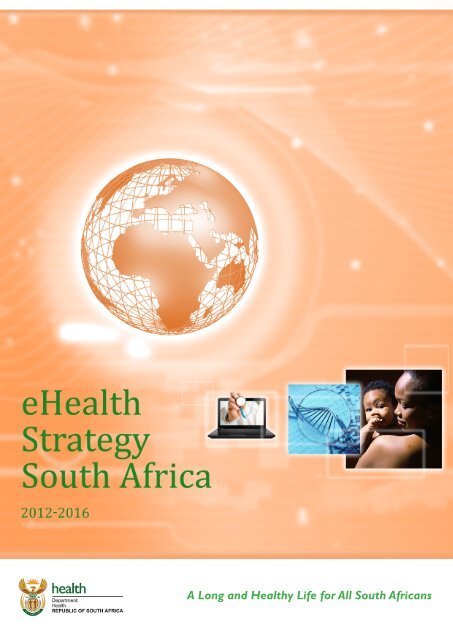
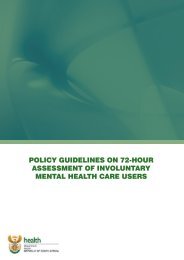
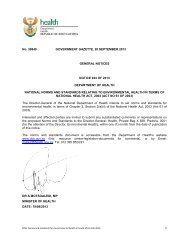

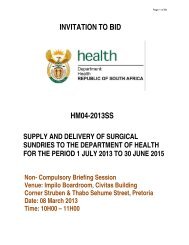
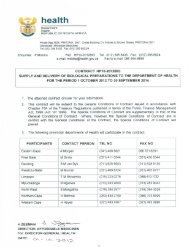
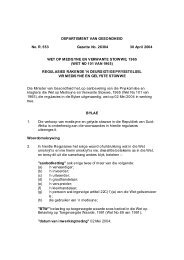
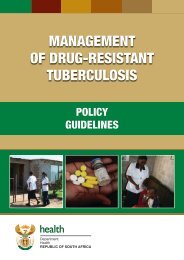
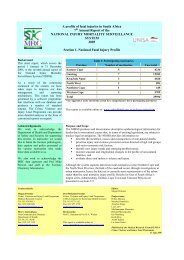
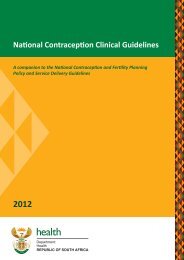
![A monograph of the management of postpartum haemorrhage [2011]](https://img.yumpu.com/15578784/1/184x260/a-monograph-of-the-management-of-postpartum-haemorrhage-2011.jpg?quality=85)
